
About UsThe Numismatic Bibliomania Society is a non-profit association devoted to the study and enjoyment of numismatic literature. For more information please see our web site at coinbooks.org SubscriptionsThose wishing to become new E-Sylum subscribers (or wishing to Unsubscribe) can go to the following web page link MembershipThere is a membership application available on the web site Membership Application To join, print the application and return it with your check to the address printed on the application. Print/Digital membership is $40 to addresses in the U.S., and $60 elsewhere. A digital-only membership is available for $25. For those without web access, write to: Charles Heck, Treasurer
AsylumFor Asylum mailing address changes and other membership questions, contact Terry at this email address: terrywhite5475@yahoo.com SubmissionsTo submit items for publication in The E-Sylum, write to the Editor at this address: whomren@gmail.com BUY THE BOOK BEFORE THE COINSale Calendar |
- WAYNE'S WORDS: THE E-SYLUM JULY 24, 2019
- NBS EVENTS AT 2019 ANA WORLD'S FAIR OF MONEY
- NEW BOOK: UNDERSTANDING THE COINS OF BENGAL
- NEW BOOK: COINAGE OF THE RASHTRAKUTAS
- NEW BOOK: AUSTRIA-HUNGARY TOKEN CATALOG
- NEW BOOK: OLUF GERHARD TYCHSEN (1734-1815)
- KRAUSE NUMISMATIC PERIODICALS UNDER AIM
- COLONIAL NEWSLETTER UPDATE ON NEWMAN PORTAL
- NEWMAN PORTAL PERIODICAL TAGS UPDATED
- VIDEO: AWARDS CEREMONY FOR BANK NOTES
- 22,000 ANA MONEY MUSEUM ?ITEMS DIGITIZED
- COUNTING U.S. COIN MINTAGE FIGURES
- NOTES FROM E-SYLUM READERS: JULY 21, 2019
- JIM NEISWINTER'S NEW YORK NUMISMATIC TOUR
- OLD COIN-RELATED LINE ART
- VOCABULARY TERM: DIE RETOOLING
- VERNON BURGAR (1861-1944)
- REMEMBERING JAY CLINE 1934-2015
- ANA HONORS DISTINGUISHED NUMISMATISTS
- WAYNE'S NUMISMATIC DIARY: JULY 21, 2019
- U.S. MINT MINT CONSIDERING COLORIZATION
- HOARD OF 60 ROMAN DENARII FOUND IN SUFFOLK
- HOLOCAUST VICTIM BASEMENT COIN COLLECTION FIND
- 13TH CENTURY BULGARIAN COIN FIND
- REGULATED GOLD 6400 REIS
- STRIKING THE 1856-S SEATED DIMES
- ARMSTRONG APOLLO 11 GOLD ROBBINS MEDAL SOLD
- A NEW NEW JERSEY COPPER
- APP OFFERS FRACTIONAL SHARES OF MAJOR COLLECTIBLES
- FBI INVESTIGATING BASEBALL CARD DOCTORING
- BANK OF ENGLAND'S £50 ALAN TURING NOTE
- LOOSE CHANGE: JULY 21, 2019
Click here to access the complete archive
To comment or submit articles, reply to whomren@gmail.com
Content presented in The E-Sylum is not necessarily researched or independently fact-checked, and views expressed do not necessarily represent those of the Numismatic Bibliomania Society.
WAYNE'S WORDS: THE E-SYLUM JULY 24, 2019
 This week we open with a
reminder of NBS events at next month's ANA convention, four new books on world numismatics, an update on the former Krause Publications periodicals, and
Newman Numismatic Portal and ANA museum updates.
This week we open with a
reminder of NBS events at next month's ANA convention, four new books on world numismatics, an update on the former Krause Publications periodicals, and
Newman Numismatic Portal and ANA museum updates.
Other topics this week include U.S. coin minting figures, numismatic sights in New York City, die retooling, coin colorization, new coin hoards, regulated gold, the Alan Turning banknote, and Neil Armstrong's gold Apollo 11 Robbins medal.
To learn more about the coins of Bengal, The Colonial Newsletter, the Republic of Minerva coin, creative coin collections, how to hold coins, Vernon Burgar's half cents, dealer Jay Cline, medals of Jeanne Stevens-Sollman, and the 2021-dated Morgan and Peace silver dollar commemoratives, read on. Have a great week, everyone!
Wayne Homren
Editor, The E-Sylum
NBS EVENTS AT 2019 ANA WORLD'S FAIR OF MONEY
NBS President Tom Harrison submitted this reminder of NBS events at next month's American Numismatic Association World's Fair of Money. I hope to see many of your there! -Editor
 As the Numismatic
Bibliomania Society celebrates its 40th anniversary, I would like to remind everyone of the upcoming NBS events at the ANA Convention in Rosemont. Highlights
of the week will feature the NBS club table located near literature dealers Charles Davis and Kolbe & Fanning. We will be displaying special items from
Friday's benefit auction. In addition, for a $25 donation, you will receive a NBS 40th anniversary commemorative coffee mug. Please stop by and share your
enthusiasm and ideas for the betterment of NBS.
As the Numismatic
Bibliomania Society celebrates its 40th anniversary, I would like to remind everyone of the upcoming NBS events at the ANA Convention in Rosemont. Highlights
of the week will feature the NBS club table located near literature dealers Charles Davis and Kolbe & Fanning. We will be displaying special items from
Friday's benefit auction. In addition, for a $25 donation, you will receive a NBS 40th anniversary commemorative coffee mug. Please stop by and share your
enthusiasm and ideas for the betterment of NBS.
Our Symposium is scheduled for Thursday the 15th at 1:00 in room 23. We are delighted to welcome American Numismatic Society Deputy Director, Dr. Gilles Bransbourg, sharing news from the ANS. Also, we are looking forward to NBS Vice President, Len Augsburger's, presentation about the legendary first six volumes of The Numismatist.
On Friday in room 44 at 11:30 our General Meeting will include the announcement of The Asylum author award winners. As well, we are looking forward to Newman Numismatic Portal Coordinator, Len Augsburger, and The E-Sylum Editor, Wayne Homren, reporting on the Newman Numismatic Portal and The E-Sylum respectively. The meeting will also feature our one major annual fundraiser, the all important benefit auction.
We hope you will be able to join us to connect with friends, old and new, as we support the mission of the NBS. Finally, I would like to share a sincere word of gratitude to the many staunch supporters of the NBS whose combined efforts will ensure another successful week of biblio fun and fellowship!
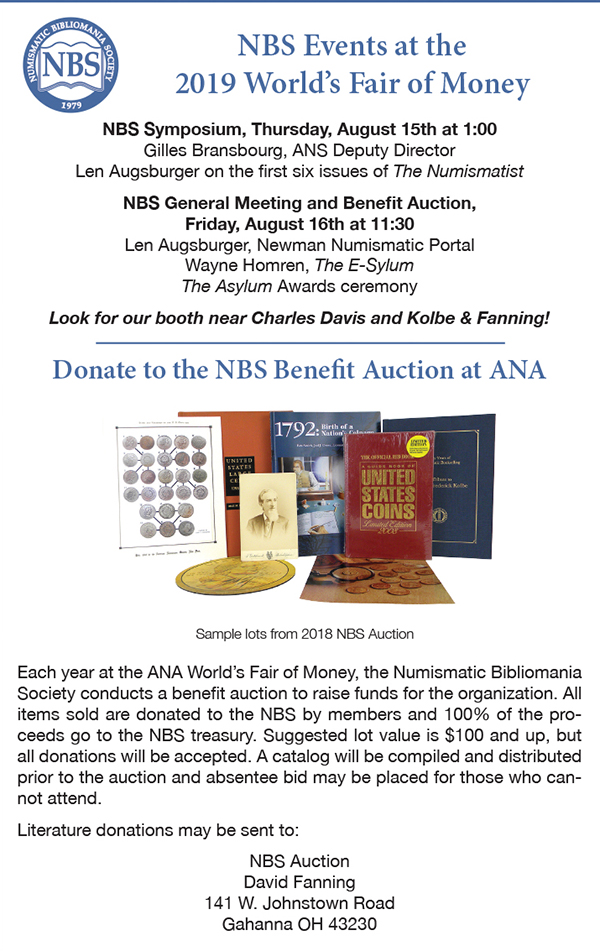
NEW BOOK: UNDERSTANDING THE COINS OF BENGAL
As noted in earlier articles, sites like PrintsAsia.com may be able to offer better deals for books published in India, but here's a new title available from Bagchee.com. Below is their overview for a new book on the coinage of Bengal. -Editor
Understanding the Coins of Bengal: Ancient to Early Modern Period
 This volume helps in understanding coins issued by different dynasties and kingdoms of Bengal from
ancient to the early modern period. It provides illustrations of legends and in particular cases images or figures on both sides of coins. Though this work is
not an attempt to document new information to the history of Bengal, a couple of new numismatic discoveries have been discussed in the volume.
This volume helps in understanding coins issued by different dynasties and kingdoms of Bengal from
ancient to the early modern period. It provides illustrations of legends and in particular cases images or figures on both sides of coins. Though this work is
not an attempt to document new information to the history of Bengal, a couple of new numismatic discoveries have been discussed in the volume.
The focal point of the volume is on the coins that were in use as money in Bengal during Magadha Janapada, Gupta dynasty, Pala era, Harikela and Akara kingdoms, Sultanate and Nawabs’ period and finally the early East India Company period. A few coins of the neighbouring kingdoms, have also been illustrated in the last chapter as they are supposed to have been in use in at least some parts of Bengal because of political, topographical and/or other reasons.
This volume would be of immense interest to scholars of South Asian numismatics and the history of the two Bengals. Md. Shariful Islam is Professor at the Institute of Business Administration in the University of Rajshahi in Bangladesh. He received his PhD degree from the University of Rajshahi. He is a life member of the Bangladesh Numismatic Collectors Society. His upcoming numismatic projects are dedicated to Bengal sultanate. Md. Mosharrof Hossain is a staff reporter at the Bangladesh Sangbad Sangstha (BSS), the national news agency of Bangladesh. He is a life member of the Bangladesh Numismatic Collectors Society.
Understanding the Coins of Bengal: Ancient to Early Modern Period
Authors (s): Md. Shariful Islam (Author) , Md. Mosharrof Hossain (Author)
Format: Hardcover
ISBN-13: 9789388540155
Pages: 178p., Plates;
Pub. date: 13.06.2019, 1st ed.
Publisher: Manohar Publishers & Distributors
Bagchee price: US $ 163,80
Member price: US $ 147,42
For more information, or to order, see:
Understanding the Coins of Bengal: Ancient to
Early Modern Period (http://www.bagchee.com/books/BB120666/understanding-the-coins-of-bengal-ancient-to-early-modern-period)
NEW BOOK: COINAGE OF THE RASHTRAKUTAS
Here's a new title on coins of medieval India. -Editor
History and Coinage of the Rashtrakutas
 For long, no coins were
known or, more correctly, identified of the Rashtrakutas, one of the most powerful dynasties of early medieval Deccan. While this was an enigma for many,
others like the proponents of the theories of feudalism and paucity of coins in early medieval India used this to support their arguments. It was only in 1996
that the first Rashtrakuta coins were conclusively identified, and since then many a types of Rashtrakuta coins have come to light in the public domain and
private collections. It was therefore a desideratum that a catalogue of the coins of this important dynasty be published.
For long, no coins were
known or, more correctly, identified of the Rashtrakutas, one of the most powerful dynasties of early medieval Deccan. While this was an enigma for many,
others like the proponents of the theories of feudalism and paucity of coins in early medieval India used this to support their arguments. It was only in 1996
that the first Rashtrakuta coins were conclusively identified, and since then many a types of Rashtrakuta coins have come to light in the public domain and
private collections. It was therefore a desideratum that a catalogue of the coins of this important dynasty be published.
IIRNS Publications LLP is therefore happy to announce the release of the book entitled History and Coinage of the Rashtrakutas by Gautam Jantakal, Bhushan Kapadia & Prakash Jinjuvaidya. This book not only compiles and catalogues all the known varieties of Rashtrakuta coins, it also gives a brief account of the various aspects of Rashtrakuta history, usage of coin terms in Rashtrakuta inscriptions.
History and Coinage of the Rashtrakutas
Authors (s): Gautam Jantakal (Author) , Bhushan Kapadia (Author) , Prakesh Jinjuvadiya (Author) History and Coinage of the Rashtrakutas
Format: Hardcover
ISBN-13: 9788193829127
Pages: 72p., Catalogue of 65 Coins; 3 Tables & 2 Maps; Softcover; Coloured Printing.
Pub. date: 24.05.2019, 1st ed.
Publisher: IIRNS Publications
Language (s): English
Bagchee price: US $ 69,30
Member price: US $ 62,37
For more information, or to order, see:
History and Coinage of the Rashtrakutas
(http://www.bagchee.com/books/BB120386/history-and-coinage-of-the-rashtrakutas)

NEW BOOK: AUSTRIA-HUNGARY TOKEN CATALOG
Yosef Sa'ar passed along a link to a new book on Austro-Hungarian tokens and emergency coins. Thanks! Here's a Google-translated summary from the publisher's web site. -Editor
 CATALOG OF TOKENS FROM AUSTRIA-HUNGARY AS DOWNLOAD - EXTENDED EDITION AVAILABLE
CATALOG OF TOKENS FROM AUSTRIA-HUNGARY AS DOWNLOAD - EXTENDED EDITION AVAILABLE
The collector Erich Heisler from Vienna has created a catalog of the tokens, advertising stamp and emergency coins from the Austro-Hungarian Monarchy over the years . In 2016, on more than 250 pages, based on his own collection, he presented over 600 brands of almost 440 issuers with historical backgrounds to editions and various types of stamps.
In a new edition from April 2019, this work has now grown to more than 860 pages with over 1000 brands from over 760 distribution points !
Erich Heisler also offers the PDF of this new catalog as a free download .
If you have any hints or additions to this catalog, please send them directly to the author Erich Heisler (heisler.erich@a1.net ). Should extensive additions arise, these would be taken into account in a revised version of the catalog.


Yosef adds:
"For anyone that collects tokens of the Austro-Hungarian Monarchy and the Austrian Republic, it should be very easy to use. The eighteen-page index is a big benefit."
To read the complete article, see:
CATALOG OF TOKENS FROM
AUSTRIA-HUNGARY AS DOWNLOAD - EXTENDED EDITION AVAILABLE
(https://wertmarkenforum.de/katalog-zu-wertmarken-aus-oesterreich-ungarn-als-download-erweiterte-auflage-verfuegbar)
To download the complete book, see:
https://wertmarkenforum.de/Downloads/Heisler_Marken_Oesterreich-Ungarn.pdf
NEW BOOK: OLUF GERHARD TYCHSEN (1734-1815)
Yosef Sa'ar passed along a CoinsWeekly article about numismatic scholar Oluf Gerhard Tychsen. Thanks! Here's a Google-translated summary from the publisher's web site. -Editor
 The Rostock scholar Oluf Gerhard Tychsen (1734-1815) and his international networks
The Rostock scholar Oluf Gerhard Tychsen (1734-1815) and his international networks
By Rafael Arnold
Ed. By Michael Busch / Hans-Uwe Lammel / Hillard von Thiessen
ISBN: 978-3-86525-699-7
304 pages
Hardcover
Published on 21.06.2019
German English
€ 29,50
Oluf Gerhard Tychsen (1734-1815), son of a Danish non-commissioned officer, who was initially trained in Halle at the Institute Judaicum et Muhamedicum to the Jews missionary and 1760 began a university teacher career, was one of the very large, pan-European networkers of his time. Of these, the correspondence received bears eloquent testimony with just under 200 letter partners. His areas of specialization were Oriental Studies and Numismatics, his places of action were the Mecklenburg Fridericiana in Bützow, which existed only for 30 years, and since 1789 the Rostock University, in whose library the entire estate has been preserved. A special feature of his correspondence are the almost 1000 letters that Tychsen associates with Mecklenburg Jews.
Not only the multilingualism of his works and letters, which in addition to modern European languages ??encompassed Latin and Greek as well as Aramaic, Hebrew and Arabic, is striking and a challenge for any researcher. His almost restless, many areas of knowledge comprehensive and In his mind, collecting activities reminiscent of a pre-modern polyhistor combine with efforts to methodologically differentiate oriental philology. Above all, his expertise in cuneiform writing has made him very well known, while his positioning on the Vellaschen made fakes harm him.
Texts by historians, Orientalists, Yiddish, Judaizers, Romanists, Numismatics and medical historians from Germany, Israel, Poland, Russia and Italy are combined in the volume, the erosion of scholarship in the late Dixhuitième and the historiographic decline paradigm of the smaller German universities in the 18th century puts the test bench. The focus is on three main topics: Tychsens scholar networks and the formation of Orientalism, its relations with Jews and its exemplary contributions to scientific numismatics.
For more information, or to order, see:
Der Rostocker Gelehrte Oluf Gerhard Tychsen (1734–1815) und seine
internationalen Netzwerke (https://www.wehrhahn-verlag.de/public/index.php?ID_Section=2&ID_Product=1315)
To read the CoinsWeeklyarticle, see:
Oluf Gerhard Tychsen (1734-1815)
(https://coinsweekly.com/oluf-gerhard-tychsen-1734-1815/)
KRAUSE NUMISMATIC PERIODICALS UNDER AIM
Tom Michael of Active Interest Media / Krause Publications writes:Attached is the first official press release regarding new ownership of the various Krause Publication magazine titles. Active Interest Media (AIM) now owns and will continue to publish Numismatic News (NN), World Coin News (WCN), Bank Note Reporter (BNR) and Coins Magazine (CM). All employees who stayed on are in the process of transferring over to AIM and everyone is working hard to never miss a deadline.
Though the Standard Catalog of World Coins and other numismatic books were purchased by Penguin Random House, AIM has retained our database of coin and banknote information and Tracy Schmidt and I have stayed on to continue our work in building and refining the database for future projects and offerings.
We are excited to be working with a great company whose focus on enthusiast audiences matches so closely with our KP history.
We know it has been a confusing transition and so felt it was important to share with the hobby this wonderfully positive outcome.
A reworded version of the release appears as a Numismatic News article on their web site. Here's an excerpt. Gerry Tebben and others passed this along. Thanks. -Editor
 North America’s leading
participant media company today announced the acquisition of four storied groups of enthusiast brands from F+W Media. “The addition of Writer’s Digest, Popular
Woodworking, Horticulture, and the Collectibles Group significantly extends our footprint in passionate markets that fit Active Interest Media’s vision for
future growth,” said President & CEO Andrew Clurman. “These groups bring a combined publishing history of more than 300 years and audiences that demonstrate
incredible loyalty through their attendance at events, participation in online conversations, and high rates of membership and subscription renewal.”
North America’s leading
participant media company today announced the acquisition of four storied groups of enthusiast brands from F+W Media. “The addition of Writer’s Digest, Popular
Woodworking, Horticulture, and the Collectibles Group significantly extends our footprint in passionate markets that fit Active Interest Media’s vision for
future growth,” said President & CEO Andrew Clurman. “These groups bring a combined publishing history of more than 300 years and audiences that demonstrate
incredible loyalty through their attendance at events, participation in online conversations, and high rates of membership and subscription renewal.”
The brands will become part of AIM’s existing Home Group, a thriving operation based in Des Moines, Iowa, that includes leading woodworking and gardening brands such as The Woodsmith and Garden Gate. “We were attracted to this acquisition by the obvious synergies between our audiences, content capabilities, and consumer-focused products,” said Home Group President Peter Miller. “These brands have diversified from their print roots to include robust digital, event, online education, and other business extensions, and there’s a lot both sides can learn from each other.”
The Collectibles Group
The Collectibles Community covers several categories including antiques, automotive, music, sports, coins (including Numismatic News, Bank Note
Reporter, World Coin News and Coins), and military. Across eleven brands, passionate consumers find news, industry trends, reviews, and
Collectibles’ most important area of distinction – its world-renowned valuations, which are the gold standard among insurers, auction houses, dealers, and
collectors.
Tom adds:
We are so pleased with the outcome and I know collectors will be relieved too!
I'm glad to hear the periodicals will continue to be published. What's still unclear is what Penguin Random House will do with the book titles it acquired such as the whole Standard Catalog series. Will they license the pricing databases from AIM? Start over from scratch? Or what? -Editor
To read the complete article, see:
Active Interest Media Acquires Four F+W
Groups Including Numismatics (https://www.numismaticnews.net/article/active-interest-media-acquires-four-fw-groups-including-numismatics)
To read earlier E-Sylum articles, see:
F+W MEDIA ASSET SALES SCHEDULED (https://www.coinbooks.org/v22/esylum_v22n17a10.html)
F+W MEDIA ASSET SALES UPDATE (https://www.coinbooks.org/v22/esylum_v22n24a10.html)
F+W MEDIA ASSET SALES APPROVED (https://www.coinbooks.org/v22/esylum_v22n25a06.html)

COLONIAL NEWSLETTER UPDATE ON NEWMAN PORTAL
Colonial Newsletter has been updated on the Newman Numismatic Portal. Project Coordinator Len Augsburger provided the following report. -Editor
 With the kind permission of the American Numismatic Society (ANS), The Colonial Newsletter has
been updated on Newman Portal through the 2017 year. The completes the digitization of the “old format” Colonial Newsletter, which was succeeded by the
Journal of Early American Numismatics in 2018. The Journal of Early American Numismatics is capably edited by Chris McDowell and is
available from the ANS on a subscription basis. The most recent issue continues the long running debate on the origin of the Continental Dollar, one of the
more enduring and enigmatic questions in American numismatics. Also included in this issue is a substantial article by Q. David Bowers on the life of John J.
Ford, Jr.
With the kind permission of the American Numismatic Society (ANS), The Colonial Newsletter has
been updated on Newman Portal through the 2017 year. The completes the digitization of the “old format” Colonial Newsletter, which was succeeded by the
Journal of Early American Numismatics in 2018. The Journal of Early American Numismatics is capably edited by Chris McDowell and is
available from the ANS on a subscription basis. The most recent issue continues the long running debate on the origin of the Continental Dollar, one of the
more enduring and enigmatic questions in American numismatics. Also included in this issue is a substantial article by Q. David Bowers on the life of John J.
Ford, Jr.


Image: Continental Dollar, Newman 3-D, from Newman IV (Heritage Auctions, 5/2014), lot 30423. One of four known in silver, realized $1,410,000. Image courtesy of Heritage Auctions.
Link to The Colonial Newsletter on Newman Portal:
https://nnp.wustl.edu/library/publisherdetail/511327
Link to subscribe to the Journal of Early American Numismatics:
http://numismatics.org/store/cnl
NEWMAN PORTAL PERIODICAL TAGS UPDATED

Newspapers, magazines and club journals aren't the only publications issued on a periodical basis. The Newman Portal includes hundreds of periodical titles of many types on many subjects. To help make sense of the collection and ease browsing, NNP has category tags in the periodical section.
As a consultant to the Portal, one of my recent chores was to review and revamp these category tags. I took a look at the complete collection and attempted to define common-sense tags in multiple dimensions such as Geographic Scope (Local, State, Regional, World, etc.) Issuer Type (Organization, Dealer, Government etc) and Era (Ancient, Colonial, Civil War, etc).
The primary category is Publication Type. These include not only House Organ, Fixed Price List, Price Guide and Prices Paid For List, but also Counterfeit Detection and Cambist.
House Organs include Wayte Raymond's Coin Collector's Journal, The Elder Monthly and Mehl's Coin Circular. Cambists are publications describing the metal content in circulating coins, which prior to 1857 in the U.S. included many, many foreign coins which circulated as legal tender. The cambists (often called "Coin Chart Manuals" were indispensible for merchants and today provide a window into the circulating coinage of the time.
Please have a look and test out the tags. Let us know what you think. It's also a great way to discover holes in the collection. You can't ask Google which numismatic house organs are in its index, but you can easily see that with NNP. What are we missing?
-Editor
To browse periodicals in NNP, see:
https://nnp.wustl.edu/library/periodicals
VIDEO: AWARDS CEREMONY FOR BANK NOTES
These are selections from the David Lisot Video Library that feature news and personalities from the world of coin collecting. David has been attending coin conventions since 1972 and began videotaping in 1985. In 2017 the Newman Numismatic Portal reached an agreement to list all David’s videos on their website. Each week an excerpt of a different video is available on the CoinTelevision YouTube channel.
Here's one on the International Paper Money Show Awards Ceremony. -Editor
 The International Paper Money
Show has some of the most competitive exhibits about the history of paper money and bank notes. Collectors compete for cash prizes for the best displays. A
dozen different awards were presented with Robert Moon winning Best of Show.
The International Paper Money
Show has some of the most competitive exhibits about the history of paper money and bank notes. Collectors compete for cash prizes for the best displays. A
dozen different awards were presented with Robert Moon winning Best of Show.
This video is a highlight from International Paper Money Show. The IPMS has non-stop action for those who collect, investigate, buy, sell, and trade paper money and banknotes of the world. Participants can see world class competitive exhibits and attend lectures sponsored by the major bank note organizations delivered by the best researchers in the paper money industry. If you want to talk paper money you need to come to the IPMS!
The entire interview is available on the Newman Numismatic Portal at:
https://nnp.wustl.edu/library/multimediadetail/522852
An excerpt of the video is available for viewing on the Coin Television YouTube Channel at:
https://youtu.be/I3w7Sf75BF0
International Paper Money Show Awards Ceremony for Bank Notes 2019.
VIDEO: 6:55
Lyn Knight, Sponsor, Presenter, Robert Vandevender, Vice President, Society of Paper Money Collectors, David Lisot, Video Producer, CoinTelevision.com.
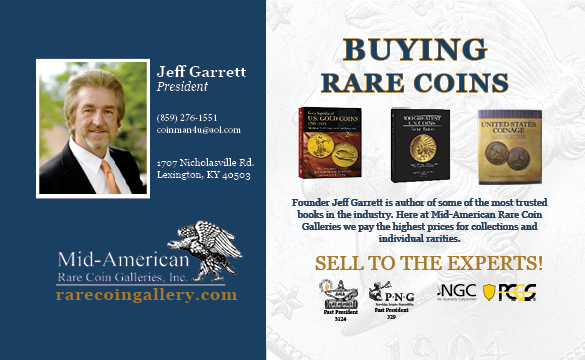
22,000 ANA MONEY MUSEUM ?ITEMS DIGITIZED
The July 2019 Money Mail e-newsletter from the American Numismatic Association included this reminder that images of many of the pieces in the ANA's collection are available online. -Editor

Online Money Museum Collection Accessible to Public
The American Numismatic Association's Edward C. Rochette Money Museum is home to tens of thousands of numismatic items. While the museum offers exhibits such as "The History of Money," the "Harry W. Bass Jr. Gallery" and "Money of Empire: Elizabeth to Elizabeth" — as well as a virtual museum — many objects are rarely on display.
Fortunately, many items from the collection are now available to view online. Museum staff has been uploading data for display since 2014, and now over 22,000 items are available in the online Money Museum Collection. Anyone can browse treasures and study data and images of each specimen. The goal is to have up to 100,000 objects available to view.
"There are many benefits to this ongoing project," said Museum Curator Douglas Mudd. "The goal is to enhance security, make the collection more accessible to the public and for research purposes—meeting the ANA's educational mission."

To explore the ANA collection, see:
Welcome to the Edward C. Rochette Money Museum’s Online Collections Database!
(https://www.money.org/money-museum/museum-collection)
COUNTING U.S. COIN MINTAGE FIGURES
Regarding U.S. coin mintage figures in the Red Book, Howard Cohen writes: I'm trying to figure out -
when they list mintage figures for individual denominations - does that INCLUDE the quantity in the mint sets?
I'm trying to figure out -
when they list mintage figures for individual denominations - does that INCLUDE the quantity in the mint sets?
Good question. I would suspect the latter, that total mintage figures would INCLUDE coins in mint sets. I reached out to longtime E-Sylum contributor Ken Bressett, Editor Emeritus of the Red Book (A Guide Book of United States Coinage). -Editor
Ken Bressett writes:
This is a perennial problem for everyone because the Mint is not always consistent in their reporting. In most cases the two figures are separate and not inclusive.
Whitman Publishing Senior Editor Diana Plattner writes:
I’m the Red Book’s production editor, which means I coordinate the pricing and other edits and generally ride herd on the process. I also compile the mintages from the Mint’s published figures each year. The short answer is, yes, the single-coin mintages include the set mintages, so you don’t have to add the single coins to the sets to get an additional mintage figure.
Mintages for Proofs are derived a bit differently from those for circulating coins. For each Proof denomination, I figure out which sets it was included in (Proof Sets, Silver Proof Sets, Limited Edition Proof Sets, etc.), then add up the most recent numismatic sales for those sets. For circulating coins, I simply pick up the Mint’s most recently published production figures. The Mint pulls from this supply to make its regular Mint Sets, so the coins in those sets are already accounted for in the numbers the Mint publishes.
In the example above, the total mintage is 5,150,150. If the 19xx coin is a circulation strike, 1,150,150 of the coins went into sets and 4 million went into circulation. If 19xx is Proof, all 5,150,150 went into Proof Sets.
Thanks! Makes sense. -Editor
To read an earlier E-Sylum article, see:
NEW BOOK: 2019 GUIDE BOOK OF U.S. COINS
(https://www.coinbooks.org/v21/esylum_v21n10a02.html)
NOTES FROM E-SYLUM READERS: JULY 21, 2019
More on the Republic of Minerva Coin
Patrick Heller writes:
 Back in 1972 I was one of four University of Michigan students who hoped to be among the first settlers of the
Republic of Minerva. The project ultimately fell through from two problems. 1) An ocean-going tug in New York harbor that was to have transported some of us
exploded and sank. 2) The king of Tonga took a crew of criminals to the Minerva reefs to build a shelter and then laid claim that the reefs were part of Tonga.
A Canadian supporter of the Minerva settlement project offered the King $25 million to build a state of the art television broadcast station for Tonga if the
king would relinquish claims to Minerva, but the king never accepted the offer.
Back in 1972 I was one of four University of Michigan students who hoped to be among the first settlers of the
Republic of Minerva. The project ultimately fell through from two problems. 1) An ocean-going tug in New York harbor that was to have transported some of us
exploded and sank. 2) The king of Tonga took a crew of criminals to the Minerva reefs to build a shelter and then laid claim that the reefs were part of Tonga.
A Canadian supporter of the Minerva settlement project offered the King $25 million to build a state of the art television broadcast station for Tonga if the
king would relinquish claims to Minerva, but the king never accepted the offer.
Back to the coins. There was only one issue, a $35 coin dated 1973 mostly struck in pure silver but with a pure gold overlay of the goddess Minerva on the obverse. The initial mintage was 8,500 pieces by the Letcher Mint in Lancaster, California. A few years later, a libertarian publisher named Robert Kephart paid to have 2,000 more pieces struck and acquired the dies used to strike them.
Because of my interest in the Minerva project, Liberty Coin Service has bought and sold hundreds of these coins over the decades. In the early 1980s, Kephart offered to sell us the dies but no deal was ever made. Presumably the dies are out there somewhere in private hands.
How cool to be a part of that history. Interesting tug-of-war. Thanks for the background! -Editor
To read the earlier E-Sylum article, see:
COINS OF THE REPUBLIC OF MINERVA (https://www.coinbooks.org/v22/esylum_v22n28a22.html)
Paper Coins of Leiden NOT Made From Bibles
Jeff Zarit's comment last week perpetuated the myth Bouke Jan Van der Veen was trying to dispel - that the paper emergency coins of Leiden were made from Bibles. Bouke wrote back to set this straight. Thanks! -Editor
Bouke Jan Van der Veen writes:
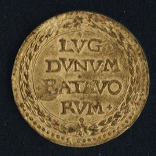 The use of specific bibles is a part of the myth; the paper came not from bibles but
was ordered by a local trader. One of the paper rounds shows a text fragment from the Latin Bible. Probably not the complete text from the Bible but a comment.
The round is made from Matheus 7 vs. 16-17 etc. I know this because it is a headline in capitals in the early 16th century print (or late 15th century) and not
the passages from the bible-chapter.
The use of specific bibles is a part of the myth; the paper came not from bibles but
was ordered by a local trader. One of the paper rounds shows a text fragment from the Latin Bible. Probably not the complete text from the Bible but a comment.
The round is made from Matheus 7 vs. 16-17 etc. I know this because it is a headline in capitals in the early 16th century print (or late 15th century) and not
the passages from the bible-chapter.
We'll look forward to the publication of this research in English so future writers and cataloguers can be more precise. -Editor
To read the earlier E-Sylum article, see:
THE PAPER EMERGENCY COINS OF LEIDEN (https://www.coinbooks.org/v22/esylum_v22n27a10.html)
NOTES FROM E-SYLUM READERS: JULY 14, 2019 : More on the Paper Emergency Coins of Leiden
(https://www.coinbooks.org/v22/esylum_v22n28a08.html)
More Creative Collections
Tom Caldwell of Northeast Numismatics writes:
Outside the box collections to consider: In regards to a different way to consider collecting we recently had a client that came up with a different way to consider collecting. Yes, first year of issue collecting is somewhat of a common way to collect however this collectors goal was to go for any issues that have the same date in a last year of issue as well as the subsequent first year.
For example 1909 Indian cents & 1909 Lincoln cents, 1916 mercury 10c & 1916 barber 10c. 1873 Trade & seated dollars & the list goes on. Some more challenging than others, Then there is always 1913 Buffalo 5c & (well good luck this one) 1913 Liberty nickels.
This could be a fun collecting challenge depending on grade & budget.
Great idea - I like it. -Editor
To read the earlier E-Sylum article, see:
LOOSE CHANGE: JULY 14, 2019 : Creative Collections
(https://www.coinbooks.org/v22/esylum_v22n28a27.html)

JIM NEISWINTER'S NEW YORK NUMISMATIC TOUR
In earlier issues we discussed places of numismatic interest in New York City. Jim Neiswinter offers this itinerary for a self-directed walking tour. Thanks! Try it sometime! -Editor
Start the tour at the foot of Broadway at Bowling Green. This is the oldest and smallest park in the city. The iron picket fence that surrounds the park was installed by the British in the 1770s.
39 Broadway.just north of the park. There is a plaque on this building that says George Washington lived at this address for 8 months in 1790 before the capital was moved to Philadelphia.
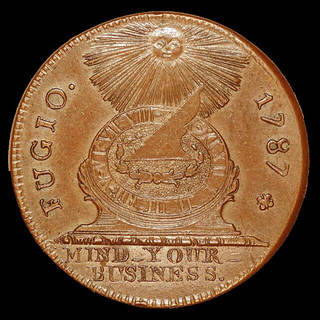 48 Wall St. The Museum of
Finance. This site was the headquarters for the Bank of New York before it became a museum. The BNY was founded by Alexander Hamilton in 1784 and moved to 48
Wall St. in 1796. It was at this site that a hoard of uncirculated Fugio cents was first discovered in 1856, and rediscovered in 1926. These cents were handed
out to new customers.
48 Wall St. The Museum of
Finance. This site was the headquarters for the Bank of New York before it became a museum. The BNY was founded by Alexander Hamilton in 1784 and moved to 48
Wall St. in 1796. It was at this site that a hoard of uncirculated Fugio cents was first discovered in 1856, and rediscovered in 1926. These cents were handed
out to new customers.
33 Liberty St. The Federal Reserve Bank of N.Y. Two differences between Fort Knox and the Fed: 1. Most of the gold at the Fed belongs to other countries while all the gold at Ft. Knox belongs to the United States. 2. The Fed gives free tours to their underground vault while Ft. Knox does not allow visitors.
96 Fulton St. This former bank was home to the American Numismatic Society from 2004 to 2008 when it moved to its present site at the corner of Canal and Varick St.
146 Fulton St. was the first address for Scott’s Stamp and Coin Co. In 1882 the company moved to 721 Broadway.
 1 Ann St. at the corner of Broadway. From 1852 to 1866 William Smith worked here as an
engraver. William Woodward named him “Smith of Ann St.” because he was so impressed with his work of re-engraving low grade 1793 & 94 cents into high grade
1793 cents. These cents fooled many collectors of that era. It was J. N. T. Levick who incorrectly called these cents counterfeits. Directly across
Broadway is St. Paul’s church where George Washington was a member.
1 Ann St. at the corner of Broadway. From 1852 to 1866 William Smith worked here as an
engraver. William Woodward named him “Smith of Ann St.” because he was so impressed with his work of re-engraving low grade 1793 & 94 cents into high grade
1793 cents. These cents fooled many collectors of that era. It was J. N. T. Levick who incorrectly called these cents counterfeits. Directly across
Broadway is St. Paul’s church where George Washington was a member.
121 Essex St. This was the home of Augustus Sage where the first meeting of the ANS was held in March 1858. The picture on page 118 in the Dave Bowers book American Numismatics Before the Civil War is of a five story building at this address that was built in 1874, so it was not the building where the first meeting of the Society was held. Sage died in Feb. 1874.
Astor Place and 4th Ave. - Cooper Union: This engineering school opened in 1859. It was here that Abe Lincoln gave his first New York City campaign speech in 1860. The ANS held early meetings there. Called the Cooper Institute when it first opened, it was also the site for coin auctions in the 1860s and 70s.
139 E. 14th St. is where Edouard Frossard had his office starting in 1877.
904 Broadway at the corner of E. 20th St. This is where Joseph Levick opened his coin store in 1860 after moving from Philadelphia. Two years earlier, in a house just down the block at 28 E. 20th St., Teddy Roosevelt was born. This house is a National Historical Site and a museum.
32 E. 23rd St. is where Thomas Elder opened his first coin store in the city in 1902.
This tour would end like it began - at a non numismatic site: The block of W. 28th St. between 5th and 6th Aves. was the center of the music business in this country from the late 1880s to the 1940s. This is where people like Irving Berlin and George Gershwin would go to get their music published. It was known as Tin Pan Alley. There are 4 or 5 brownstones on the north side of the street that are still there that housed the publishing companies. There is talk these buildings might become Historical Sites.
So there you have a mostly numismatic walking tour that would probably take 2 hours to complete with about 4 miles of walking – and we’ve just gotten to midtown.
Jim adds: "I just realized I mentioned 3 of the 4 presidents on Mt. Rushmore. Did Jefferson ever make it to NYC?" I asked Dr. Google, and found an answer on Wikipedia and elsewhere. -Editor
In the spring of 1790, Thomas Jefferson rented a house at 57 Maiden Lane when he moved to New York to serve as the Secretary of State under George Washington. His dinner on June 20, 1790 at that house with Alexander Hamilton and James Madison produced the Compromise of 1790, whereby Hamilton won the decision for the national government to take over and pay the state debts, while Jefferson and Madison obtained the national capital (District of Columbia) for the South. The dinner was celebrated in the song "The Room Where It Happens" in the Broadway musical Hamilton.
So, I guess one could argue that the redemption of colonial currency is a numismatic connection, but the location is worthy of mention regardless. I also reached out to researcher Joel Orosz for comment. -Editor
Joel writes:
The only time Jefferson was in NYC that I know of was while the federal capital was there, from 1789-1790, after which it was moved to Philadelphia. It was in New York, however, that Jefferson submitted to Congress his Report on the Subject of Establishing a Uniformity in the Weights, Measures, and Coins of the United States, which had a significant influence upon the Senatorial Committee that drafted the Mint Act of 1792.
To read the complete article, see: Maiden Lane (Manhattan) (https://en.wikipedia.org/wiki/Maiden_Lane_(Manhattan))
ANS Example of 1793 Cent re-engraved by Smith of Ann Street:
Copper cent, Philadelphia (Pa.), 1793. 1950.147.27
(http://numismatics.org/collection/1950.147.27)
To read earlier E-Sylum articles, see:
NUMISMATIC WALKING TOUR OF LOWER MANHATTAN
(https://www.coinbooks.org/v21/esylum_v21n22a30.html)
NEW YORK CITY NUMISMATIC TOURS (https://www.coinbooks.org/v22/esylum_v22n27a09.html)
MORE ON NEW YORK CITY NUMISMATIC TOURS
(https://www.coinbooks.org/v22/esylum_v22n28a09.html)
OLD COIN-RELATED LINE ART
Gary Beals writes:About 1965 I was loaned some old numismatic books dating back to the 1800s. I photographed a couple of pictures in pages that caught my eye. I was a junior in college.


In examining the coins please hold them thus
The 1890 or so Victorian era art may have been designed to be a poster for a coin shop. It is charming. New collectors certainly need to learn how to hold
coins — especially those pieces close to uncirculated.
I wonder if anyone has more details on how this common sense poster or book panel came into existence. It is no doubt a British item.
Women workers at the U.S. mint
This line drawing documents that women were employed by at least one of the U.S. mints. Safety issues concerning work clothing certainly need to be discussed
here, loose garments having been caught in machinery and doing great harm to the wearer.
Cool! Thanks! -Editor
VOCABULARY TERM: DIE RETOOLING
Dick Johnson submitted this entry from his Encyclopedia of Coin and Medal Terminology. Thanks. I added an image of the discussed medal found on the Goldberg's auction archive. -Editor
Die Retooling. Retouching a die once it has been made and put into use. Dies are retooled for a number of reasons: to grind off a clash mark, or to correct an error or die flaw; but perhaps most common is to update a die, to change the lettering or figures, as to change the year to a current one. Also common is to deepen relief after a die has worn extensively and some further use is demanded of it.
Die retooling is done by a number of metalworking methods, including grinding, polishing, lapping, engraving, punching, chasing and others. Usually a die will be softened first before any work is performed then rehardened by heat treating afterwards (although some tool and dieworkers prefer to do grinding or polishing on a hardened die). Transfer dies in particular are almost always retooled before sinking a new working die. If the image transferred from a die that is worn from prolonged use, the transfer die is retooled to sharpen up the worn images.
Die retooling always creates a new state of the die, causing a new variety in pieces struck from such a retooled die. Numismatists like to study such varieties. See re-engraving, alteration, variant, die variety.
If the change in the die is greater than simple retooling at the time of a new issue, where a new die is required with some design change after it was once placed in production, it is called transitional design. If the previous design was unacceptable and the design change was made to correct it, the previously struck items are known as prototypes.
Die Retooling Covers Up Die Flaws
The two varieties of this medal dramatically illustrate the use of die retooling to save a die. The 1889 Washington Inaugural Centennial Brooklyn Bridge Medal
was first struck with a clear sky above the bridge on the reverse. The medal was created by 19th century engraver George Hampton Lovett.
The medal was cataloged by Susan H. Douglas for her 1959 work published in The Numismatist (Douglas 7 and 8). She quotes a previous Washington medal collector, L. Bayard Smith (whose collection and records had been obtained by F.C.C. Boyd). Smith stated that Lovett had "struck only 18 or 20" of this variety then he added the sun and rays over the bridge to cover a "defect in the die."


From Goldberg's 9/2/2012 sale Lot 1100
Lovett had retooled the die, cutting new lines in the background within the circular panel and below the tiny legend. His sunken lines created raised relief lines in the struck piece. By doing this he was able to salvage a die that otherwise would have exhibited the die flaw. To obtain as many pieces as possible (before a die breaks) he struck the white metal medals first (because it is softer), then the bronze. This evidence of die retooling delights collectors. It gives them more than one variety to collect.
Reference:
O16x {1949} Douglas 7-8.
Looking for the meaning of a numismatic word, or the description of a term? Try the Newman Numismatic Portal's Numismatic Dictionary at: https://nnp.wustl.edu/library/dictionary
Or if you would like a printed copy of the complete Encyclopedia, it is available. There are 1,854 terms, on 678 pages, in The Encyclopedia of Coin and Medal Technology. Even running two a week would require more than 19 years to publish them all. If you would like an advance draft of this vital reference work it may be obtained from the author for your check of $50 sent postpaid. Dick Johnson, 139 Thompson Drive, Torrington, CT 06790.

VERNON BURGAR (1861-1944)
Vernon Burgar (1861-1944), was born on October 20, 1861, in Stamford, Delaware County, New York, son of Reverend James Morris Burgar (1830-1902), a Methodist minister, and Sarah Ann Kerr (1830-).
Burgar was a music teacher and lifelong numismatist. He specialized in English copper and silver that circulated in British colonial North America, U. S. Cents & Half Cents. Very little is known about him and nothing about the whereabouts of his coin collection.
In 1870, his father was a minister at Coeymans, New York, where he went to school.
Burgar studied music and became a music teacher and organist.
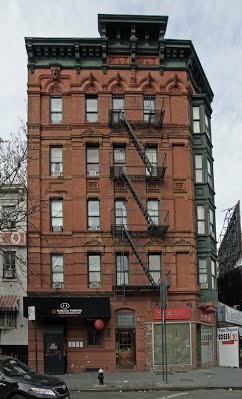 In 1890, he lived at Philip Goerlitz's newly built carved brownstone
apartment building - 61 Grove Street, West Village, New York City, New York, where he taught music Monday through Friday. He spent his weekends at home in Sing
Sing.
In 1890, he lived at Philip Goerlitz's newly built carved brownstone
apartment building - 61 Grove Street, West Village, New York City, New York, where he taught music Monday through Friday. He spent his weekends at home in Sing
Sing.
He appears to have lived for forty years with a Canadian woman four years younger named Marian W. Corley, who worked as his housekeeper.
Burgar correspondence with the Chapman Brothers, postmarked November 18, 1895.
"Dear Sir: Many thanks for your announcement of the Winsor sale.If you care to you may send me, to address written above [Emwilton Place, Sing Sing, N.Y.] a plain catalogue and I may be able to send you some bids. My chief interest has been in foreign coppers. Still I would like to better the conditions of many of my U. S. Cents & Half Cents. It is very difficult to know what prices to offer for them without seeing the coins. By the way I have not heard from you in regards to the Bronze tetra Drachms of Athens. I thought if you could sell them at $1.50 each I could afford Christmas presents for my friends. I spend five days each week in New York and one here. V. Bulgar. My father, a clergyman, resides here permanently."
In October, 1905 he applied for membership in the ANA. He became ANA Member No. 759.

Burgar's ad in The Numismatist, October 1906
The 1928 Ossining City Directory lists him as a music teacher living at 9 Emwilton Place, Ossining, Westchester County, New York.
He died on May 27, 1944, and is buried in Dale Cemetery, Ossining, Westchester County, New York.
Would anyone know of any coins in collections today that can be traced back to Vernon Burgar? The Newman Numismatic Portal led me to a note on p23 of Roger Cohen's American Half Cents: The "Little Half Sisters" (Second Edition) where Burgar is listed alongside Lyman Low, Henry Miller and Dr George French as having loaned coins for photographing in the Gilbert book.
Gilbert's Varieties of the United States Cents of 1796, coauthored with Thomas Elder, was published in 1909 and revised in 1916. NNP also has digitized copies of these, but Burgar's name doesn't seem to appear, so I'm not sure where Cohen got that information. But Gilbert plate coins are likely to have documented pedigrees. Any information anyone may have would be appreciated. Burgar's an otherwise obscure collector not well known today. Thanks to John Lupia for bringing him to life for us. I reached out to Bill Eckberg, author of The Half Cent, 1793-1857: The Story of America's Greatest Little Coin for comment. -Editor
Bill writes:
I never heard of the guy. But even the very finest half cent collections before 1960 are very poorly known. So, I can’t say that the fact that I haven’t heard of Burgar means anything. The Gilbert plate coins aren’t pedigreed in his book, so there is probably no way to suss Burgar’s coins from the group.
To read the complete article, see:
BURGAR, VERNON
(https://sites.google.com/a/numismaticmall.com/www/numismaticmall-com/burgar-vernon)
The entire inventory of the Lupia Numismatic Library is for sale. Individual items will be available before the remaining archives are broken up into parcels sold at philatelic auctions in the U. S. and Hong Kong. Check NumismaticMall.com frequently as dozens of new items with estimates will be posted daily until everything is sold.
All inquiries will be given prompt and courteous attention. Write to: john@numismaticmall.com .
REMEMBERING JAY CLINE 1934-2015
An article on the Stack's Bowers blog feed discusses numismatic author and dealer Jay Cline. -Editor

In January 2015 the numismatic world was saddened to learn of the passing of J.H. Cline, who had been part of the numismatic world for over 52 of his 81 years. Known as "Jay the Beard" to some friends and recognized by many others for his signature top hat, Jay was a fixture at countless regional and national conventions. Cline's Rare Coins on Salem Avenue in Dayton, Ohio was a meeting place for collectors and dealers to buy, sell, and converse—a "coin club" that was very popular in its day. Jay, his wife Vicki, and some family members then relocated to Palm Harbor, Florida, where he continued his numismatic activities.
While Jay was knowledgeable on just about every aspect of American numismatics, his first love and specialty was Standing Liberty quarters struck from 1916 to 1930. His book, Standing Liberty Quarters remains the standard reference on the subject and has gone through four editions.
A list of his numismatic memberships is long and ranges from local clubs to national and regional associations. From 1970 through 2014 he was a familiar figure at American Numismatic Association conventions, save for just two years. He contributed to many publications including the Blue Book, Red Book, and ANA Grading Standards for United States Coins. When asked for help or information, he always stepped forward.
Whenever a notable Standing Liberty quarter made the news, Jay would write about it. When Bowers and Merena Galleries sold the Louis E. Eliasberg quarters at auction in 1997, he wrote concerning the MS-65 1916:
"This one was probably purchased by Eliasberg before the breakup of several rolls of 1916s in an estate in the Northeast. I saw one of these rolls in 1953/1954. All were blast white and I believe many were sold by New York dealer Lester Merkin. I purchased my first 1916 from Lester. Presently, it is in an NGC MS-65 FH holder. Interestingly, the 1916 Standing Liberty quarter is the only 20th century coin that the Salomon Brothers and Stack's put into a portfolio that compared coins with other investments. Incidentally, this investment comparison ended in 1991."
Jay's life was a Horatio Alger story personified. He was born in Richlands, Virginia, one of eight children in a coal miner's family of modest means. At an early age he learned the value of hard work combined with diligence and education. After completing his secondary education he moved to Ohio "with a new pair of shoes and eleven dollars in my pocket," per his own telling. He lived with his brother while gaining a foothold, married, and worked hard to provide for his family. Rare coins were a passion, and on weekends he traveled to attend coin shows. Cline's Rare Coins opened in 1964 and was popular from the outset.
In 1981 he married for the second time. Seeking a helper for the business he advertised for "a gal Friday." That gal turned out to be Vicki. Their combined family consisted of five children and ten grandchildren. She was introduced to numismatics, caught on quickly, and became a buyer and salesperson. She reluctantly retired in 2018 after 40 years in the business.
Vicki has consigned some of Jay's personal favorite numismatic items to our World's Fair of Money auction. Particularly notable is a 1916 quarter accompanied with a letter from its designer, Hermon A. MacNeil.
As to Jay, all of us in the numismatic world are richer for his having come our way.
To read the complete article, see:
J.H. Cline - Did You Know?
(https://www.stacksbowers.com/News/Pages/Blogs.aspx?ArticleID=remembering-j-h-cline)
ANA HONORS DISTINGUISHED NUMISMATISTS
This ANA press release announces winners of several major awards to be presented at next month's World's Fair of Money. Congratulations to all! -Editor
Every year, the American Numismatic Association (ANA) recognizes members who go above and beyond with their service and dedication in numismatics. Awards are given to those who display a passion for the hobby, a willingness to expand it and a pride in being involved. The following awards will be presented at the Chicago World's Fair of Money in Rosemont, Ill., during the Member and Awards Celebration, Aug. 15.
The Adna G. Wilde Jr. Memorial Award for Exemplary Service recognizes ANA members who dedicate their time and resources to further the educational purposes of the Association and the hobby, and who set an example for others.
The award this year will be presented to life member Kerry K. Wetterstrom of Millersville, Penn.
 Wetterstrom joined the ANA in 1974
at age 14. The recipient of a young numismatic scholarship, he attended the ANA Summer Seminar in Colorado Springs in 1979. Not long after, Wetterstrom
actively began recruiting new members and making charitable donations of cash and numismatic material to the Association. He became a life member in 1986.
Wetterstrom joined the ANA in 1974
at age 14. The recipient of a young numismatic scholarship, he attended the ANA Summer Seminar in Colorado Springs in 1979. Not long after, Wetterstrom
actively began recruiting new members and making charitable donations of cash and numismatic material to the Association. He became a life member in 1986.
Since 1996, he has served as president, secretary, treasurer, education chair and bourse chair for four international, regional and local organizations. In addition, he is a member of more than 15 other numismatic groups. Over the past two decades, he has written many articles for educational publications and also is a contributing editor for The Numismatist.
Named a Numismatic News Numismatic Ambassador in 1998, Wetterstrom has demonstrated his passion for promoting the hobby in the ANA's District Representative Program, in which he served for many years in local and regional capacities. He has delivered informative lectures to audiences in 12 states; presents three to four educational programs annually to clubs in central Pennsylvania; and speaks to school classrooms and civic organizations. He has taught courses at the ANA Summer Seminar for more than 20 years and has been an ANA exhibit judge since 1996.
The Medal of Merit is bestowed on members who have dedicated years of service to numismatics.
 The medal is being presented to coin
dealer and ANA Past President H. Robert Cambell. At age 11, he became a collector, and not long after founded a club with four boys from his
neighborhood. By 21 he had turned a hobby into his profession.
The medal is being presented to coin
dealer and ANA Past President H. Robert Cambell. At age 11, he became a collector, and not long after founded a club with four boys from his
neighborhood. By 21 he had turned a hobby into his profession.
Since 1996, the knowledgeable dealer has taught courses on counterfeit, altered and artifically toned coins at the Association's Summer Seminar. In recognition of his years of teaching collectors, Campbell received an honorary "Doctor of Numismatics" degree at the event in 2016.
First elected to the ANA Board of Governors in 1997, Campbell became president just two years later. During this time, he testified before a U.S. Senate committee that was studying U.S. coinage design practices. He's remained active in the ANA, serving on the Advisory Council since 2001.
In 2007 Campbell chaired the state committee to select potential designs for Utah's entry in the U.S. Mint's 50 State Quarters program. He has contributed to A Guide Book of United States Coins (the "Red Book") and the Coin Dealer Newsletter. His 2014 book, Utah Trade Tokens, is considered the go-to reference on the topic and received a Numismatic Literary Guild award for "Best Token and Medal Book."
Campbell owns and operates a successful firm, All About Coins, Inc., which he used to frequent as a young collector. He belongs to and has led almost every coin club in the state. Campbell has received numerous accolades during his decades in the hobby. Most notably, Numismatic News recognized him as a Numismatic Ambassador in 1988, and he received an ANA Glenn Smedley Memorial Award in 1999.
 The Numismatic Art Award for
Excellence in Medallic Sculpture recognizes an individual whose imaginative compositions transcend circulating coins.This year's recipient is
Magdalena Dobrucka of Poland.
The Numismatic Art Award for
Excellence in Medallic Sculpture recognizes an individual whose imaginative compositions transcend circulating coins.This year's recipient is
Magdalena Dobrucka of Poland.
Dobrucka studied medal engraving at the Academy of Fine Arts in Warsaw in 1971-76, where she learned the basics of low relief. Dobrucka says her work is characterized by deep relief, which is not typical of medals, and that each piece represents her search for an unconventional solution.
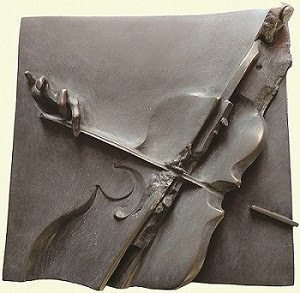 The accomplished artist has won numerous awards, and her work is part of many private and museum collections.
She has participated in every exhibition sponsored by the International Art Medal Federation since 1976 and has been a member of the organization since 1993.
In 1994 she was surprised and honored to win its Grand Prix for her cast bronze medal The Violoncellist. She also is proud of her Columbus quincentenary
medal, the 57th issue of the American Numismatic Society (ANS). Her highly sculptural design was selected in an international competition that elicited more
than 100 entries from 16 countries.
The accomplished artist has won numerous awards, and her work is part of many private and museum collections.
She has participated in every exhibition sponsored by the International Art Medal Federation since 1976 and has been a member of the organization since 1993.
In 1994 she was surprised and honored to win its Grand Prix for her cast bronze medal The Violoncellist. She also is proud of her Columbus quincentenary
medal, the 57th issue of the American Numismatic Society (ANS). Her highly sculptural design was selected in an international competition that elicited more
than 100 entries from 16 countries.
Dobrucka says her art is inspired by humanity, and every award she has received "is a joy and encouragement for [my] work."
Harry J. Forman Dealer of the Year honors a professional numismatist who shows uncommon dedication to strengthening the hobby and the ANA, and displays exemplary ethical standards as a numismatic dealer.
Mark Salzberg is this year's recipient. As chairman and grade finalizer at Numismatic Guaranty Corporation (NGC) and chairman and co-founder of Certified Collectibles Group, the dealer's numismatic roots run deep.
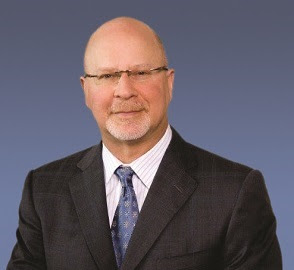 Born in Flemington, New Jersey,
Salzberg became interested in collecting at age seven, when he received a 1903 Indian Head cent. His father gave him his first coin book, and a lifelong
passion began.
Born in Flemington, New Jersey,
Salzberg became interested in collecting at age seven, when he received a 1903 Indian Head cent. His father gave him his first coin book, and a lifelong
passion began.
He was hired by John Albanese to work in a local coin shop only four years later. When Albanese founded NGC in 1987, he asked his longtime friend to join his new company. Salzberg started as a grading finalizer in 1988, became president in 1991, and was promoted to CEO in 1998.
Salzberg worked as a vest-pocket dealer in high school and during his time as a college student. "I was making more money than the teachers," he recalls. In 1978 he became a full-time dealer.
A member of the Professional Numismatists Guild, Salzberg is serious about hobby education. He has been an instructor at the ANA Summer Seminar and avidly supports its programs. In 1998 he was presented an ANA Presidential Award, and he was named the ANA's Numismatist of the Year in 2006.

WAYNE'S NUMISMATIC DIARY: JULY 21, 2019
Tuesday July 16, 2019 was special in two ways - it was the first time my Northern Virginia numismatic social group Nummis Nova began meeting on the 3rd Tuesday of the month (to avoid conflict with the recently-formed Fairfax Coin Club), and it was a night when we welcomed several out-of-town guests and two surprise visitors.
We met at J. Gilbert's restaurant in Mclean, VA. Joining us would be my friend Tom Uram and four of his fellow members of the Citizen's Coinage Advisory Committee (CCAC), who were in town for an official meeting the next day. Also joining us was my old friend Pat McBride who accompanied Tom on his drive from Western Pennsylvania, where both are heavily involved with the Pennsylvania Association of Numismatists.
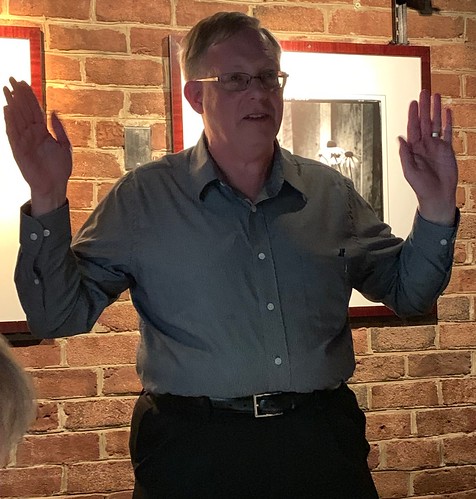 I started off by welcoming everyone and
kicking off a long round of introductions that was stopped and started a few times to allow for the waitstaff to do their jobs. I understand everyone enjoyed
their meal, which is our usual experience at this place (Photo by Tom Kays).
I started off by welcoming everyone and
kicking off a long round of introductions that was stopped and started a few times to allow for the waitstaff to do their jobs. I understand everyone enjoyed
their meal, which is our usual experience at this place (Photo by Tom Kays).
Our Nummis Nova attendees included regulars Steve Bishop, former CCAC member Roger Burdette, Joe Esposito, Wayne Herndon, Wayne Homren, Tom Kays, Jon Radel, Eric Schena and Dave Schenkman.
Current CCAC member visitors included Erik Jansen, Mary Lannin, Don Scarinci, Jeanne Stevens-Sollman and Tom Uram.

Clockwise from left: Roger Burdette, Erik Jansen, Steve Bishop (hidden), Joe Esposito, Jon Radel, Jeanne Stevens-Sollman, Wayne Homren (standing), Mary Lannin (hidden), Don Scarinci (hidden), Wayne Herndon, Tom Uram. Pat McBride, Dave Schenkman and Eric Schena (Photo by Tom Kays)
But we had a couple of surprise visitors as well. I had been driving to the restaurant after work when Tom Uram phoned me to let me know he and Pat had already arrived and been shown our room. They were waiting in the bar.
Just a few minutes later I got an excited call from Tom - "you'll never guess who we just ran into here!! - Dick Peterson!!" Richard Peterson succeeded Ed Moy in Mint leadership and was the longest-serving acting director/deputy director in the U.S. Mint's history, serving from January 2011 through March 2017. He was succeeded by acting directors Rhett Jeppson and David Moti until the appointment of David J. Ryder in 2018.

Beverly Ortega Babers, Jon Cameron, Tom Uram, Richard Peterson
Dick was there meeting with two former Mint colleagues, Jon Cameron and Beverly Ortega Babers, former Deputy Assistant Secretary for Management and Budget at the Department of the Treasury. Later Dick and Jon stopped by to visit with everyone (Photo courtesy Tom Uram and a willing bystander).
Tom Uram

Tom Uram and Pat McBride (Photo by Tom Kays)
 In another surprise, Tom announced that a bill was about to be introduced in the House of Representatives for 2021
Commemorative Silver dollars. Part of the surcharge would benefit numismatics, and the coins are sure to please collectors - they include 2021-dated reissues
of the Morgan and Peace silver dollar designs, including pieces struck at the old Carson City mint building and bearing the CC mint mark. He and fellow CCAC
member Mike Moran had been promoting the concept quietly for months.
In another surprise, Tom announced that a bill was about to be introduced in the House of Representatives for 2021
Commemorative Silver dollars. Part of the surcharge would benefit numismatics, and the coins are sure to please collectors - they include 2021-dated reissues
of the Morgan and Peace silver dollar designs, including pieces struck at the old Carson City mint building and bearing the CC mint mark. He and fellow CCAC
member Mike Moran had been promoting the concept quietly for months.
Tom sent me a copy of the legislation right before I left my office. I printed a copy out and brought it to the meeting where everyone present signed it. I plan to donate this great piece to the upcoming NBS fundraising donation auction. If you collect silver dollars or numismatic ephemera, be prepared to bid.
To read the complete Coin World article, see:
Legislation seeks 2021-CC Morgan
dollar struck at old Carson City Mint (https://www.coinworld.com/news/us-coins/legislation-seeks-2021-cc-morgan-dollar-struck-at-old-carson-city-mint)
Tom also brought along copies of a photo booklet he created on the Numismatic Journey of the Apollo 11 Commemorative Coin. The CCAC was involved in promoting and choosing designs for this coin honoring Saturday's 50th anniversary of the historic July 20, 1969 moon landing.

Numismatic Journey of the Apollo 11 Commemorative Coin
Pat McBride

Pennsylvania Railroad check
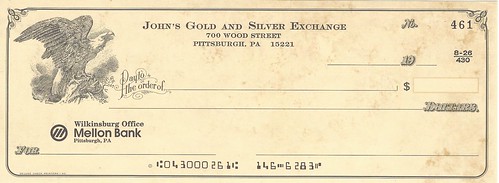
John's Gold and Silver Exchange check
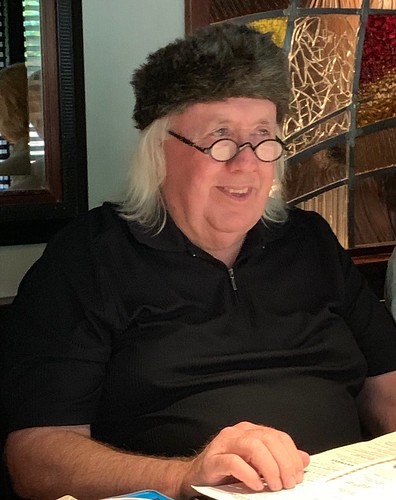 Pat brought envelopes with two numismatic presents for everyone at the dinner. First is an unused check for the
Pennsylvania Railroad Company, probably the biggest, richest and best known company in the country in its day.
Pat brought envelopes with two numismatic presents for everyone at the dinner. First is an unused check for the
Pennsylvania Railroad Company, probably the biggest, richest and best known company in the country in its day.
The second item is from the estate of numismatic literature dealer John H. Burns - a similarly unused check from the coin shop he operated for a time in the Wilkinsburg area near Pittsburgh - John's Gold and Silver Exchange.
With Pat's current hairstyle a number of people have remarked to him that he looks a lot like Benjamin Franklin. So going all in, he's planning to be a Franklin impersonator at upcoming Pittsburgh-area coin shows. He showed off his Franklin spectacles and fur hat that Franklin adopted to declare his humble frontier American roots to the French. Pat explained that Franklin was a city dweller (Boston, New York, Philadelphia) and never visited the American frontier, but the French ate it up and invited him everywhere (Photo by Tom Kays).
Dave Schenkman


Ivanpah Mining Company One Dollar Note
Dave writes:
Here's a rare one dollar mining note I just purchased, and passed around at the dinner. A two dollar denomination was sold as Lot 3031 in the October 16, 2007 Stacks sale of John Ford’s collection. I’d be interested in knowing of any other denominations.
Dave's other exhibits included a great 1802-1902 Scovill Manufacturing Company centennial medal and a 1732 Windisch-Gratz taler.
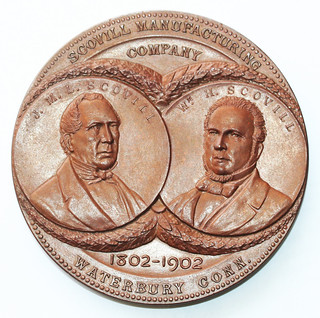

1802-1902 Scovill Manufacturing Company Medal
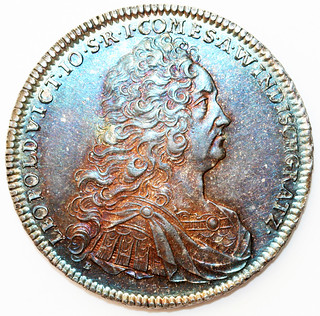

1732 Windisch-Gratz taler
Dave adds:
The 1732 Windisch-Gratz taler of Leopold Viktorin Johann is listed by Davenport as #1202. This coin was sold as lot 287 in the October 1965 sale of the Virgil Brand collection. Of all the items, the California silver mining company note is by far the rarest.
Dave can always be counted on to bring some amazing numismatic material.
Joe Esposito
Joe writes:
 One of the medals that I brought was
a hefty 81-mm bronze medal of Ernest Hemingway designed by French-Spanish medalist Andre Belo. It has a portrait of Hemingway on the obverse and an
impressionistic account of Santiago, the old fisherman, struggling to reel in a marlin on the reverse; the legend on the reverse in lower-case letters: “le
vieil homme et la mer" (the old man and the sea). This coming week marks the 120th anniversary of Hemingway’s birth. The medal usually resides in my
office, providing writing inspiration.
One of the medals that I brought was
a hefty 81-mm bronze medal of Ernest Hemingway designed by French-Spanish medalist Andre Belo. It has a portrait of Hemingway on the obverse and an
impressionistic account of Santiago, the old fisherman, struggling to reel in a marlin on the reverse; the legend on the reverse in lower-case letters: “le
vieil homme et la mer" (the old man and the sea). This coming week marks the 120th anniversary of Hemingway’s birth. The medal usually resides in my
office, providing writing inspiration.
 I also brought a medal
commemorating Robert Frost, which was issued by the California Friends of Robert Frost; I had seen a copy of it in the archives at the Robert Frost Library at
Amherst College recently and tracked down my own. This is another large piece, 89 mm, and was designed by Francis Sedgwick, who was a California sculptor and
rancher. There are various Frost medals and the poet also was awarded the Congressional Gold Medal, which President Kennedy presented to him on his birthday in
1962.
I also brought a medal
commemorating Robert Frost, which was issued by the California Friends of Robert Frost; I had seen a copy of it in the archives at the Robert Frost Library at
Amherst College recently and tracked down my own. This is another large piece, 89 mm, and was designed by Francis Sedgwick, who was a California sculptor and
rancher. There are various Frost medals and the poet also was awarded the Congressional Gold Medal, which President Kennedy presented to him on his birthday in
1962.
 Among the discussions in our area
of the table was the upcoming Virginia Numismatic Association convention and the medals and the three types of copies of Karl Goetz’s original 1915 Sinking of
the Lusitania medal. But, as usual, topics ranged beyond numismatics, including the Frank Lloyd Wright-designed landmark Fallingwater, which is not far
from next year’s ANA convention, and even popular D.C. restaurants The Dubliner and Martin’s Tavern. I appreciated the centennial medal of a church in
Pittsburgh, St. Bernard, given to me by Tom Uram, who created it, and which was designed by Joel Iskowitz and sculpted by Heidi Wastweet.
Among the discussions in our area
of the table was the upcoming Virginia Numismatic Association convention and the medals and the three types of copies of Karl Goetz’s original 1915 Sinking of
the Lusitania medal. But, as usual, topics ranged beyond numismatics, including the Frank Lloyd Wright-designed landmark Fallingwater, which is not far
from next year’s ANA convention, and even popular D.C. restaurants The Dubliner and Martin’s Tavern. I appreciated the centennial medal of a church in
Pittsburgh, St. Bernard, given to me by Tom Uram, who created it, and which was designed by Joel Iskowitz and sculpted by Heidi Wastweet.
Steve Bishop

Steve Bishop took the prize for largest numismatic item - a sea-salvaged 1756 Swedish plate money 4 Daler piece.
Tom's Take
This section is authored and illustrated by Tom Kays. Thanks!


Be Afraid Be Very Afraid by Jeanne Stevens-Sollman
Tom writes:
 Aside from what Wayne has already told you, I
sat between Joe and Jon and talked with many of the CCAC appointees regarding medallic arts and crafts. On the other side of Jon sat Jeanne Stevens-Sollman, an
award-winning medallion sculptress and environmentalist who lives in rural Pennsylvania and who observes and depicts natural and whimsical creatures found in
farm and field in her work.
Aside from what Wayne has already told you, I
sat between Joe and Jon and talked with many of the CCAC appointees regarding medallic arts and crafts. On the other side of Jon sat Jeanne Stevens-Sollman, an
award-winning medallion sculptress and environmentalist who lives in rural Pennsylvania and who observes and depicts natural and whimsical creatures found in
farm and field in her work.
She told of her dog who sniffs out mice who trap themselves in her horses’ feed buckets. The dog lifts them out unharmed and carries them about as living squeak toys giving them freedom with dog breath, and a chance to make amends for horse chow stealing.
One bronze medallion in multiple fitted layers on its epidermis freezes nose and jowls of her dog’s snout in extreme close-up with mouse tail-a-wagging. Inside the maw is a hopeful mouse, resigned to its fate after a grand banquet followed by a night in the can, that sees that snout as a terrifying apparition, yet may escape with a slobbering to warn the neighbor mice about it.
I understand Jeanne accepts commissions and it would be well worth it to engage her talents in artworks for environmental education centers.
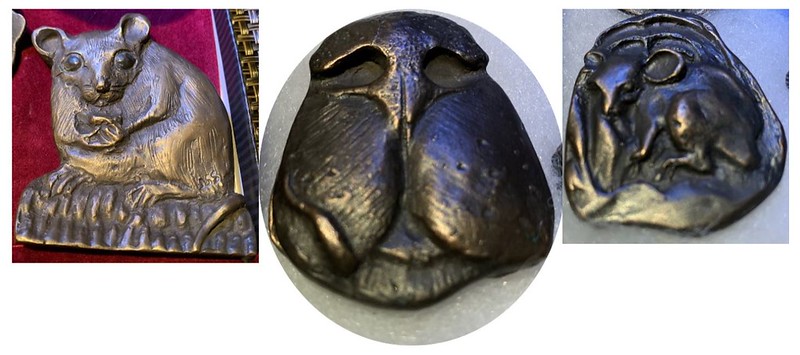
In a competition where she set about to sculpt a female of note, Jeanne chose Amelia Earhart in a touching piece with aviatrix portrait framed by riveted aircraft wreckage, juxtaposed with a butterfly wing and the word “Lost.” I get it. Nice!
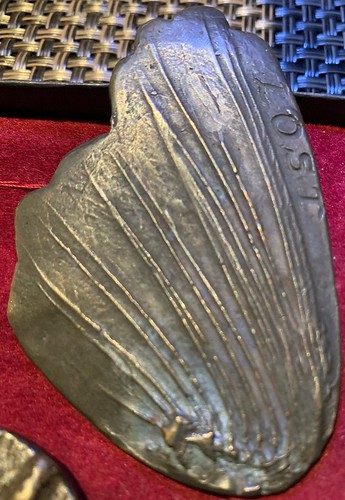

Show-and-Tell Medals were present from Nummis Nova regulars in good numbers at dinner including an Edward H. Harriman Memorial Medal for the Utmost Progress in Safety and Accident Prevention, a Scovill Manufacturing Company Centennial Medal of 1902 presented by the Company to George F. Sinclair; Joe ransacked his office to bring both a Spanish medal with the eminent face of Hemingway and reverse of the Old Man and the Sea, and a Robert Frost medal of 1963, by the California Friends of Robert Frost; and a medal designed by Karl Goetz, depicting of the Sinking of the Lusitania from 1915 (British version used for rallying the English to fight the Hun due to apparent “premeditation” as it showed the date of sailing, and not the corrected date of sinking) brought by Tom Kays.
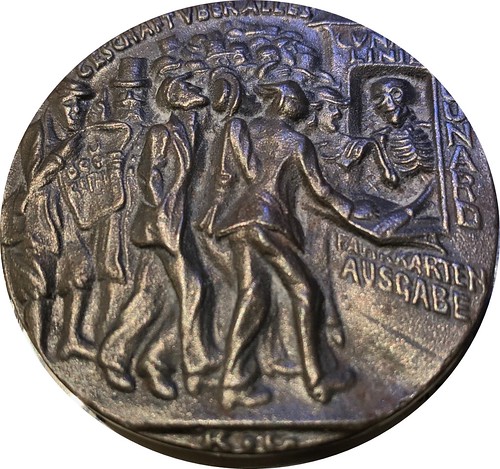

Goetz Lusitania Sinking Medal

Donald Scarinci Impresses Wayne Herndon with Invisible Medal

FROM LEFT: Pat McBride, Dave Schenkman, Eric Schena. STANDING: Dick Peterson, Jon Cameron
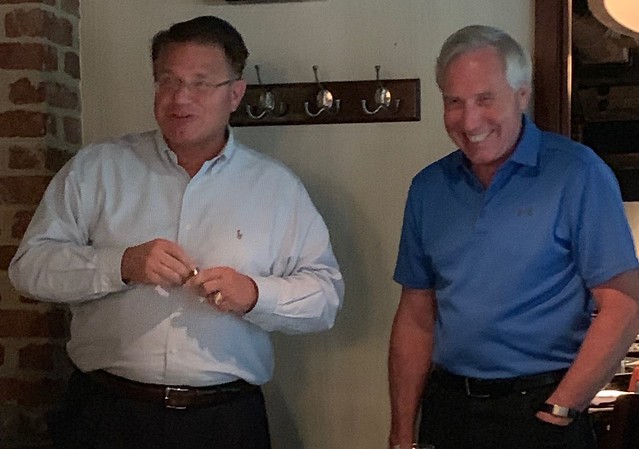
Dick Peterson, Jon Cameron


Numismatic paper at dinner included a counterfeit fifty cent fractional currency of George Washington [Received for all United States Stamps “Not Approved March 3, 1863] with an old tag reading: “Counterfeit money – Made at Stone House half mi[le] above Alliance Furnace on Jacob’s Creek, [Fayett] Co.in 1865. Cancelled and stamped “counterfeit” at [Treas.] Washington D.C. One of the first counterfeiting in the USA.” I don’t agree with the last statement, by the way. The cancellations are punched and inked with “Counterfeit” in rude letters across poor George Washington’s face.
Early American paper ephemera including lottery tickets floated past including a Washington City Lottery #1 for cutting the CANAL through the City of Washington, to the Eastern Branch Harbour (obviously this was not the winning ticket which would have been redeemed for prizes) along with a Federal City lottery ticket #2 for improvements of the Federal City (Subject to the discount of 5%), and a Grand Consolidated Lottery ticket (cost a Quarter) for internal improvements, literature, and charities in the City of Washington, [and in the States of Delaware, North Carolina, and Louisiana.] (subject to a reduction of 15%) and printed in Washington City in 1828.
Eric brought scarce obsolete paper money from New Market, Virginia, issued September 17th , 1861 in one bit (12.5 cents), ten cents and three cent denominations, payable in Virginia money when presented in sums of five dollars or more. Lastly a Payable to Bearer on Sight, One dollar bill that was issued from the Ivanpah Consolidated Mill & Mining Co at 308 California Street in San Francisco reminded us of the nationwide extent of wildcat banking in the 19th century.
Mary Lannin writes:
I always love seeing how clever and multi-layered Jeanne Stevens-Sollman's medals are....she is extremely talented!
The Ivanpah mining note is pictured above with Dave Schenkman's other material. Here are images of some of my early Washington, DC lottery tickets, with three different names for the under-construction city.

Improvement of the Federal City

The Canal Through the City of Washington
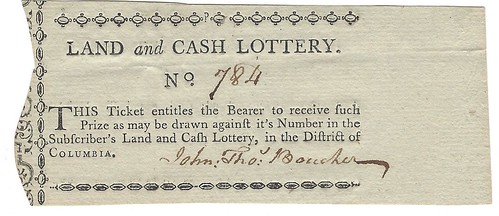
Land and Cash Lottery District of Columbia
Group Photo

Clockwise from left: Roger Burdette, Erik Jansen, Steve Bishop, Wayne Homren, Joe Esposito, Tom Kays, Jon Radel, Jeanne Stevens-Sollman, Mary Lannin (hidden), Don Scarinci, Wayne Herndon, Tom Uram. Pat McBride, Dave Schenkman (Photo by Eric Schena)
Our meetings are always enjoyable, but our guests made this quite a special evening. Thanks to everyone who attended and assisted with this article. 'Til next time!
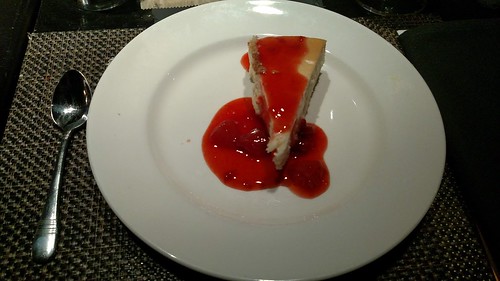
Image courtesy Wayne Homren

U.S. MINT MINT CONSIDERING COLORIZATION
I couldn't attend the public portion of this week's CCAC meeting, but here's some news published elsewhere. An article by Mike Unser on CoinNews.Net discusses the U.S. Mint's plans to add color to coins. -Editor
Adding some color to U.S. commemoratives is under consideration, the United States Mint revealed during a Citizens Coinage Advisory Committee meeting Wednesday to review candidate designs for the 2020 Basketball HOF Coins.
The U.S. Mint has never added color to coins.
"The United States Mint is considering the use of colorization on this commemorative coin program," commented April Stafford, Director of the U.S. Mint’s Office of Design Management. "I stress the word ‘considering’."
The final Basketball coin designs would play a large part in driving an eventual decision, the use of color would be subtle and limited to silver and clad coins, and any colorization would happen only after intense research and development to ensure the quality of the coins would be of the highest regard.
To read the complete article, see:
U.S. Mint Considering Colorized Coins
(http://www.coinnews.net/2019/07/17/u-s-mint-considering-colorized-coins/)
A few weeks back we discussed the Royal Canadian Mint's experiments with laser color technology. There are multiple methods for colorizing coins and the announcement gave no hint as to what method might be used. But it's an interesting development and kudos to Director Ryder and the Mint staff for considering something new. What should other world mints have all the fun? -Editor
To read the earlier E-Sylum article, see:
CANADIAN MINT'S LASER COLORING TECHNOLOGY
(https://www.coinbooks.org/v22/esylum_v22n26a25.html)
HOARD OF 60 ROMAN DENARII FOUND IN SUFFOLK
Arthur Shippee passed along this BBC News article found via The Explorator newsletter about a metal detectorist's Roman coin find in Suffolk, England. Thanks. -Editor

A hoard of Roman coins found in a field may have been hidden there during the Boudiccan revolt, an expert has said.
The trove of 60 denarii, dating between 153BC and AD60-61, was found in a field near Cookley, in Suffolk, by a metal detectorist.
Dr Anna Booth, who examined the find, said there "might be a link with the Boudiccan revolt" and the coins.
Queen Boudicca led the Iceni tribe against the Romans in AD61 which led to the destruction of Colchester.
Most of the coins dated from the Republic era, pre-27BC, but there were also denarii minted during the reigns of emperors Augustus, Tiberius, Caligula and Nero.
Dr Booth said: "This hoard is interesting because the latest coin dated to the reign of Nero in AD60-61. The final coin is often an indication of when a hoard is likely to have been deposited.
The find, from August 2018, was made up of 58 solid silver coins, two of which were silver-plated copies.
The silver-plated copies are likely contemporary counterfeits. I'm glad to see the coins were examined thoroughly. -Editor
To read the complete article, see:
Roman coin stash 'may have been linked to Boudiccan revolt'
(https://www.bbc.com/news/uk-england-suffolk-48968933)
HOLOCAUST VICTIM BASEMENT COIN COLLECTION FIND
Len Augsburger passed along this article about a Roman-era coin collection found in a basement in Hungary. Thanks. -Editor
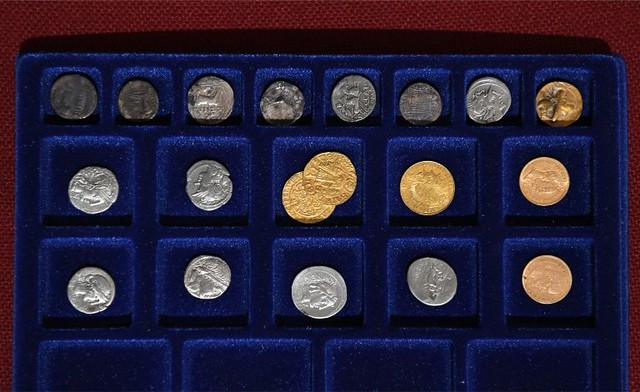
A vast and "unique" trove of antique and Roman-era coins, unearthed in what was one of Hungary's wartime Jewish ghettos, is proving a conundrum for historians.
Thrilled with the chance discovery of the 2,800 gold and silver coins spanning decades and continents, researchers are in the dark however about who collected and then hid them.
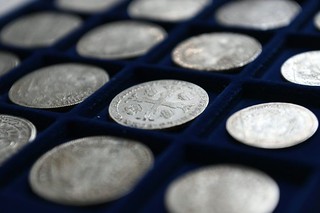 That the coins were buried under a house whose one-time owner, the likely collector, is presumed to have been
murdered in the Holocaust deepens the mystery.
That the coins were buried under a house whose one-time owner, the likely collector, is presumed to have been
murdered in the Holocaust deepens the mystery.
According to a Hungarian Jewish organisation, the hoard also exposes how gaps remain in what is known about Hungary's Jews during World War II.
The current owners of the house in the town of Keszthely, 190 kilometres (120 miles) southwest of the capital Budapest, stumbled across the coins in February during work on the cellar.
They were likely hidden by a Jewish owner who was later deported to a Nazi German death camp in 1944, said Balint Havasi, director of Keszthely's Balatoni Museum where the items are currently exhibited.
 In a letter to the museum, the building's current owners explained how they had been digging a hole in the
cellar after pumping out groundwater when they came across the hoard.
In a letter to the museum, the building's current owners explained how they had been digging a hole in the
cellar after pumping out groundwater when they came across the hoard.
"We slowly dug out five carefully sealed and buried glass jars," reads the letter seen by AFP.
"When we opened one of them, we were greeted by an amazing sight, just like in a fairy tale: hundreds of coins, real treasure," it continued.
"We hope that it can return to its legal owners one day."
To read the complete article, see:
Buried treasure poses Holocaust puzzle for Hungary
museum (https://news.yahoo.com/buried-treasure-poses-holocaust-puzzle-hungary-museum-035212678.html)

13TH CENTURY BULGARIAN COIN FIND
Arthur Shippee passed along this article found via The Explorator newsletter about a small coin find in Bulgaria. Thanks. -Editor
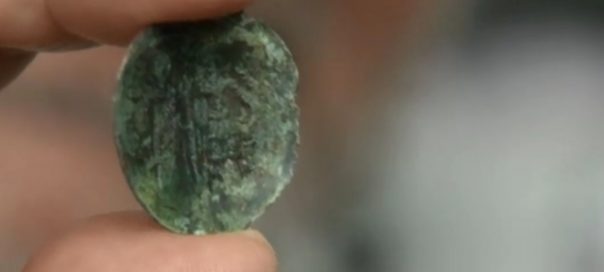
A coin from the time of Tsar Ivan Assen II, ruler of Bulgaria from 1218 to 1241, has been found at the ancient sacred site of Perperikon, archaeologist Professor Nikolai Ovcharov announced.
The coin was made in Thessaloniki, of copper and silver, and Ovcharov described it as one of the best-preserved such finds.
The coin depicts Dimitar, patron saint of Thessaloniki.
Ovcharov said that the coin, together with another found earlier, showed that at that time in the 13th century, Thessaloniki was entirely under Bulgarian influence.
Archaeological work is currently proceeding in the southern section of the site, near the remnants of a church, the largest of its kind uncovered in the Rhodope Mountains, and estimated to date from the fourth or fifth to the 14th century. The latest round of archaeological finds date from the 10th to the 13 centuries.
To read the complete article, see:
Archaeology: Coin from time of
Bulgaria’s 13th century Tsar found at Perperikon
(https://sofiaglobe.com/2019/07/20/archaeology-coin-from-time-of-bulgarias-13th-century-tsar-found-at-perperikon/)
REGULATED GOLD 6400 REIS
A July 18, 2019 Stack's Bowers blog article by James McCartney discusses an interesting regulated gold coin in the firm's upcoming ANA sale. -Editor

We are thrilled to offer a historic Brazilian 6400 reis regulated by New York City goldsmith John Burger in Rarities Night of our August 2019 ANA Auction. Any piece of Regulated Gold is a rare prize, but a connection to John Burger and the economy of America's first capital city makes this piece particularly historic. It is the quintessential survivor from this exclusive series, balancing expert production and exceptional preservation. It is sure to serve as a crowning jewel in an advanced cabinet of early American issues.
Though originally struck in Brazil in the name of a Portuguese king, this piece is effectively an American $8 gold coin created to meet the demand for coinage that arose between the colonial period and the establishment of the U.S. Mint. It is remarkably attractive, pairing rich olive-gold surfaces with hints of darker patina in the peripheries. The 6400 reis host coin, sometimes called a half Joe, shows a uniformly sharp strike and ideal centering. Minor laminations in the planchet show in the upper left and lower right fields on the reverse, though these are as-struck and not obvious to the naked eye.
A shallow clip trims the denticles from 6 to 9 o'clock relative to the obverse, and the edge is plain and unornamented. A narrow central plug is well hidden in the portrait's curls and the corresponding shield motifs, remaining completely flat and even with the surrounding surfaces. Regulated Gold scholar Ralph Gordon considered this style of plug an assay plug, meant only to assess the fineness of the coin but not to modify the weight. Burgers B hallmark, sometimes called JB due to the elaborate script, is sharply stamped in its usual location at the eye of the portrait. The mark is crisp and features the small interior break at the lower left edge that is usually seen. Just the upper loop of the B remains flat where the punch was positioned over the field without any metal to strike up. There is minor distortion on the reverse beneath Burger's mark, but this has nicely blended into the overall aesthetic.
At a modern weight of 215.3 grains (8 dwt 23 grains), the present piece is masterfully aligned to the 216 grains (9 dwt) standard valuing a "half Joe" at $8 that rose to prominence around the time of the American Revolution. We first encounter this standard proposed by the New York Chamber of Commerce on August 17, 1770, and it later went on to be adopted by the Second Continental Congress in April 1776. However, it would not be until it was officially recognized by the Bank of New York in May of 1784 that it was institutionalized as the governing standard throughout the Colonies.
This valuation would continue to be the accepted rate up through the establishment of the U.S. Mint, with the Congressional Act of February 9, 1793, calling for "the gold coins of France, Spain and the dominions of Spain [to be valued] at the rate of one hundred cents for every twenty seven grains and two-fifths of a grain." When calculated out, we see that this is virtually the same standard of 216 grains at $8 introduced two decades prior. However, the U.S. Mint would not strike its own gold coinage for circulation until 1795 and the acceptance of foreign gold coins like the 6400 reis was a crucial element of the growth in the early American economy. Regulators like Burger were essential in the maintenance of this haphazard monetary system, and the present piece is a significant relic of this foundational era.
John Burger worked in New York City after the British Evacuation in November 1783, and was advertising his services as a coin regulator as early as January 1784. A close colleague of Ephraim Brasher (who produced the legendary doubloons), John Burger was a similarly influential figure, notable for declaring Alexander Hamilton's 1804 death a murder in his capacity as city coroner. Both Burger and Brasher belonged to the New York Gold and Silversmiths Society, and they worked within a few blocks of each other in the Lower East Side of Manhattan adjacent to the East River. These men appear to have worked at the same time and to the same standard, but for different parties, as their marks often appear on the same coin, like two different stamps on a passport. Burger marks on half Joes are also known alongside the marks of Martinique, Guadeloupe, and other islands.
While the current countermark has long been familiar to scholars of the Regulated Gold series, the exact identity of the regulator was unclear until relatively recently. It was first attributed to the territory of Berbice (British Guiana) by Howland Wood in his pioneering Coins of the West Indies and Sou Marque (1915). Ralph Gordon recognized a connection to Brasher and correctly attributed the "Script B" mark to North America in his seminal West Indies Countermarked Gold Coins (1987). However, it wasn't until several years later that this mark would be confirmed as John Burger by William Swoger in a 1992 Coin World article, and then in a privately published 1999 monograph titled Burger's Doubloons.
To read the complete article, see:
John Burger Regulated 6400 Reis to be Featured in
Rarities Night of our August 2019 ANA Auction (https://www.stacksbowers.com/News/Pages/Blogs.aspx?ArticleID=regulated-6400-reis-august-ana)
STRIKING THE 1856-S SEATED DIMES
Researcher Dan Owens submitted this information relating to the S.S. Central America 1856-S Seated Dime, found in records at the National Archives - NARA (San Bruno-San Francisco) RG 104. Thanks! -Editor
Recently it was reported by Bob Evans that a lone 1856-S Seated dime was recovered amongst thousands of dimes found in a bag stored in the purser's lock box aboard the ill-fated S.S. Central America. The date represents the first year that this denomination was struck at the Branch Mint. Remarkably this coin is in gem mint state condition.
In the first three quarters of 1856, the entire year’s mintage of S Mint Seated half dollars and quarters were coined principally during the months of January, April, June and July. During the fourth quarter, the only silver coins struck were Seated dimes. On December 22nd, $7,000 in silver coin was received from the Coiner. This must have been the entire year’s mintage of 70,000 1856-S Seated dimes. Thus, most of these historic pieces were probably paid out in 1857, the year that the steamer sank.


J. R. Snyder Treasurer
To read the earlier E-Sylum article, see:
S.S. CENTRAL AMERICA FIND: FINEST 1856-S DIME
(https://www.coinbooks.org/v22/esylum_v22n24a26.html)
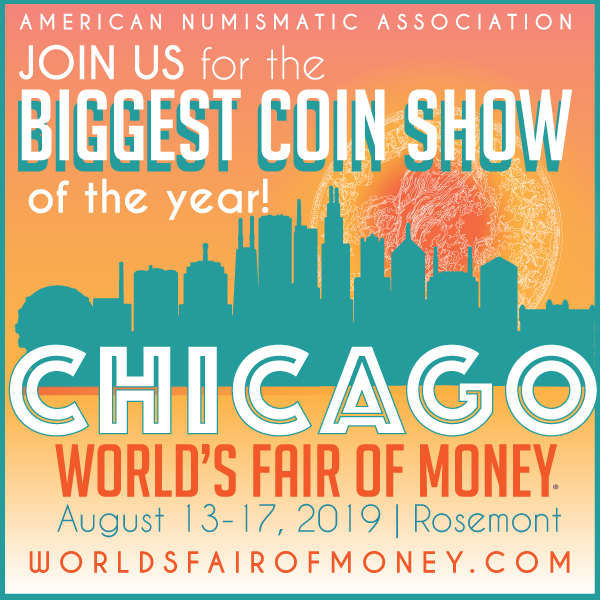
ARMSTRONG APOLLO 11 GOLD ROBBINS MEDAL SOLD
We don't typically discuss grading or prices, but I thought it was worth noting the impressive price brought by Neil Armstrong's gold Robbins medal from the Apollo 11 mission. The strong seven-figure price is in line with values of the more well-known Nobel prize medals. All are unique tributes to singular achievements for mankind. Congratulations to the new owner. -Editor


An extremely rare gold medal graded by Numismatic Guaranty Corporation® (NGC®) that traveled on the Apollo 11 mission to the moon realized $2,055,000 at an auction held on the mission's 50th anniversary. It is one of the highest prices ever paid for a medal, and it is the highest price realized to date for any item from the Armstrong Family Collection, which comprises items saved by astronaut Neil Armstrong and his immediate family members.
The gold medal is called a Robbins Medal; astronauts had these struck to bring on their missions starting with Apollo 7. On their obverse side, the Robbins Medals feature the insignia of the mission they were made for, so the Apollo 11 ones show an eagle landing on the lunar surface. This design was later adapted for the reverse of the Eisenhower and Susan B. Anthony dollars.
Only three Apollo 11 Gold Robbins Medals were struck, one for each astronaut on the mission. This one was brought along by Armstrong, who became the first man to walk on the moon’s surface on July 20, 1969.
NGC graded the medal NGC MS 67, while an affiliated company, Collectibles Authentication Guaranty® (CAG™), certified its provenance to the Armstrong Family Collection. So far, the Armstrong Family Collection, which has been entirely certified by CAG, has realized more than $11 million at auction. Heritage Auctions is conducting the sales of artifacts from this collection.
“The Apollo 11 Gold Robbins Medal is the centerpiece of one of the most important collections of memorabilia of the last 50 years,” said Mark Salzberg, Chairman of NGC and CAG. “This rare gold medal accompanied Neil Armstrong from blast-off to splashdown on that historic first mission to the moon. This is, without a doubt, one of the most significant items that NGC and its affiliates have ever certified.”
In addition to the three Gold Robbins Medals, more than 400 Silver Robbins Medals were flown on Apollo 11. They were engraved with individual numbers, and the one with serial number #9 was also offered in the Heritage sale. Graded NGC MS 66 and certified by CAG as part of the Armstrong Family Collection, it realized $52,500.
To read the complete article, see:
Neil Armstrong’s Apollo 11 Gold Medal, Certified by NGC and CAG, Realizes Over
$2 Million (https://www.ngccoin.com/news/article/7590/gold-robbins-medal-realized/)
A NEW NEW JERSEY COPPER
Michael Demling submitted this note about a new New Jersey copper coin he's created. Cool. -Editor
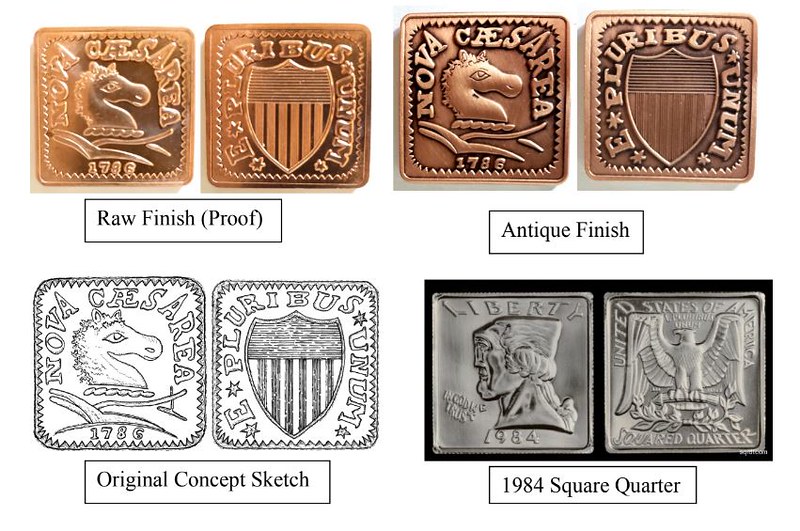
Yes my Fellow Copper Collectors there is a New New Jersey Copper!! And it is the Square Jersey. A unique creation from a Crazy Jersey Collector. I’ve been developing this Square Jersey for several years now and finally put my Idea to pen and paper for a sketch of how I envisioned what a square Jersey would look like (See above sketch)
The background story starts with a interesting Art medal created by the Metallic Art Co. in 1984. They designed, and struck 1/4 and 1/2 ounce silver metals. I had one of these medals and found them very interesting. Well I figured being a Jersey Copper specialist why not make a Square Jersey? So from sketch to hunting a mint that could produce this unusual coin just last October my idea became reality.
Here it is Pure Copper~ 31.75mm x31.75mm and comes in two finishes. Raw finish (Proof ) and Antique finish. Very limited production of two hundred copper and ten silver. Each Square Jersey Copper is signed on the edge by the Artist. Interested parties can obtain this unique copper by writing the creator at mdemling@mdaarchitects.com
APP OFFERS FRACTIONAL SHARES OF MAJOR COLLECTIBLES
Price of rare coins getting too high? Why not pool resources with others and share the cost of owning an 1804 Dollar or other seven-figure piece? Dealers have done this for years, of course, going in together on deals to buy whole collections or individual top-drawer pieces. But there hasn't been a way for the average joe collector to get in on the action. This New York Post article describes a platform that's allowing collectors in other fields do just that. Are coins next? -Editor
 Most fans could only dream
of owning a Honus Wagner baseball card, which is the most valuable in the world.
Most fans could only dream
of owning a Honus Wagner baseball card, which is the most valuable in the world.
But beginning next month, they’ll be able to buy a share of one of the roughly 50 known Wagner cards that are still in circulation, and which is worth roughly $3 million.
The price of entry: $100.
New York trading platform Rally Rd., which began selling shares of collectible cars two years ago, is now expanding into sports memorabilia, watches and rare books.
Chief Executive Christopher Bruno told The Post his company recently learned that an owner of one of the 50 or so remaining 1910-era Wagner cards was looking for some liquidity, and negotiated a deal.
Rally Rd. will be selling a minority stake in the Wagner for about $500,000.
Beginning in August, subscribers to the Rally Rd. app can start buying as many as 4,000 to 5,000 shares in the card, with each share representing about .00004 percent of the card, Bruno said.
There is no other competitor that sells shares in rare collectibles other than art, he added.
There are plans to sell shares in a first edition of “Harry Potter and the Philosopher’s Stone,” one of about 200 of the books in existence.
“We have largely a millennial audience,” Bruno said, noting that the app’s users are age 27 on average.
masterworks.io is a platform for investing in fractional shares of artworks. Of course, investment vehicles for rare coins are nothing new and while they can be successful there are many examples that have ended badly for investors. So I can already hear the snark machine asking, "What could possibly go wrong?" -Editor
To read the complete article, see:
App to let fans buy minority shares of $3M
Honus Wagner baseball card (https://nypost.com/2019/07/10/app-to-let-fans-can-buy-minority-shares-of-3m-honus-wagner-baseball-card/)
FBI INVESTIGATING BASEBALL CARD DOCTORING
The previous article in this issue described a platform for sharing ownership of very expensive rare collectibles. What could go wrong? Well, aside from the problem of physical storage and responsibility for security, what if the item turns out to be fake or altered? Read the fine print before clicking yes. Here's a Washington Post article about suspicions of rampant doctoring in the baseball card world. -Editor
 The green stadium seats
shown on the baseball card are empty as Stan Musial, wearing a crisp white uniform, grips a bat and digs in. His eyes gaze toward the pitcher over his right
shoulder, his white teeth peeking out from under a grin. It’s almost as though on this vividly colored card, issued in 1952 by the Bowman Gum Company, “Stan
the Man” has spotted a fat fastball.
The green stadium seats
shown on the baseball card are empty as Stan Musial, wearing a crisp white uniform, grips a bat and digs in. His eyes gaze toward the pitcher over his right
shoulder, his white teeth peeking out from under a grin. It’s almost as though on this vividly colored card, issued in 1952 by the Bowman Gum Company, “Stan
the Man” has spotted a fat fastball.
The card’s lone obvious blemish is a stray black print mark on the white frame. Even with the defect, it sold in an online auction in late 2017 for $2,800.
Seven months later, a 1952 Bowman Stan Musial card without that print mark sold for $28,100. Collectors have since claimed the two cards were in fact the same item, improperly altered to inflate its value then auctioned off a second time. Now, the FBI is asking questions about that card and hundreds of others like it, as a scandal over trading cards that have allegedly been fraudulently altered rocks the billion-dollar memorabilia hobby.
Federal law enforcement officials have launched a criminal investigation encompassing one of baseball card collecting’s largest appraisal firms, a well-known sports memorabilia dealer and one of the hobby’s largest auction houses, among others, according to four collectors who have been interviewed by investigators.
The scandal started after a pair of online collectors began identifying and documenting cards that were allegedly improperly modified. They’ve identified 316 such cards, retouched by nearly a dozen “card doctors,” which sold for a combined $1.4 million. The four collectors who spoke with investigators say the FBI suspects thousands of additional cards with similar issues are still circulating through the hobby. (All four collectors spoke to The Post on condition of anonymity, concerned about the repercussions of discussing an ongoing investigation.)
At the heart of the scandal is the memorabilia market’s system for assessing baseball cards, a term widely used to describe any athletic trading card. Collectors rely on grading companies — California-based Professional Sports Authenticator (PSA), part of publicly traded Collectors Universe, dominates the market — to help determine the condition and market price of cards. An improved grade can increase a card’s value several times over. Hence the existence of so-called “doctors,” who take worn cards, alter them to make them appear in better condition and resubmit them to grading companies in search of a better mark.
Investigators are asking questions about one such alleged “doctor,” Gary Moser, implicated by the online research, according to the four collectors who have talked to the FBI. Investigators are also asking about other smaller-scale “doctors,” along with PSA’s grading practices and an Oregon-based auction house, PWCC, according to those four collectors.
PWCC acknowledged in a statement that it is cooperating with law enforcement officials over cards graded by PSA and submitted by Moser. A PSA spokesman declined an interview request, but said the company was conducting its own investigation and cooperating with law enforcement. It also decertified the Musial card, a move that indicates the company no longer stands by the grade it once assigned. Moser denied ever altering cards. An FBI spokesperson would not confirm the existence of a current probe into PWCC, PSA or Moser, citing Bureau policy.
Perhaps Bob Rightmire was on to something when he wrote in our June 23, 2019 issue, "One wonders if this article exposes the tip of a widespread scandal? Caveat emptor." -Editor
To read the complete article, see:
Baseball card
collectors suspected rampant fraud in their hobby. Now the FBI is investigating.
(https://www.washingtonpost.com/sports/2019/07/18/baseball-card-collectors-suspected-rampant-fraud-their-hobby-now-fbi-is-investigating/)
To read earlier E-Sylum articles on coin doctoring, see:
ON NUMISMATIC DOCTORING AND CONSERVATION
(https://www.coinbooks.org/v22/esylum_v22n22a11.html)
MORE ON NUMISMATIC DOCTORING AND CONSERVATION
(https://www.coinbooks.org/v22/esylum_v22n23a14.html)
NOTES FROM E-SYLUM READERS: JUNE 23, 2019 : The Grade Depends on the Grader
(https://www.coinbooks.org/v22/esylum_v22n25a10.html)
BANK OF ENGLAND'S £50 ALAN TURING NOTE
Pablo Hoffman was the first to forwarded the story about the Bank of England's choice of Alan Turing for their new £50 banknote. Thanks. Here's an excerpt from a BBC News article. -Editor

Computer pioneer and codebreaker Alan Turing will feature on the new design of the Bank of England's £50 note.
He is celebrated for his code-cracking work that proved vital to the Allies in World War Two.
The £50 note will be the last of the Bank of England collection to switch from paper to polymer when it enters circulation by the end of 2021.
"Alan Turing was an outstanding mathematician whose work has had an enormous impact on how we live today," said Bank of England governor Mark Carney.
"As the father of computer science and artificial intelligence, as well as a war hero, Alan Turing's contributions were far-ranging and path breaking. Turing is a giant on whose shoulders so many now stand."
The work of Alan Turing, who was educated in Sherborne, Dorset, helped accelerate Allied efforts to read German Naval messages enciphered with the Enigma machine.
Less celebrated is the pivotal role he played in the development of early computers, first at the National Physical Laboratory and later at the University of Manchester.
To read the complete article, see:
New face of the Bank of England's £50 note is revealed as Alan Turing
(https://www.bbc.com/news/business-48962557)
Excellent choice. Turing was a pioneer and founder of our modern world - generations ahead of his time. Chip Howell, Arthur Shippee and other readers forwarded versions of the story. Thanks, everyone. -Editor
LOOSE CHANGE: JULY 21, 2019
Here are some additional items in the media this week that may be of interest. -Editor
Banknotes Celebrate and Confront History
Gerry Tebben forwarded this Washington Post article on how countries use banknotes to both celebrate and confront their own history -Editor

This week, Britain announced it would place Alan Turing, a World War II code-breaker who is now remembered as a founding father of computer science and artificial intelligence, on the nation’s new 50-pound bill.
Turing is, by any measure, a national hero. But his legacy has for decades had a sad ending that reflected badly upon Britain: Despite his intellect and reputation as a war hero, he died of suicide after he was convicted of engaging in homosexual activity, which was then a criminal offense in the country.
Britain isn’t the first nation to try to correct its history through bank notes. Below are five other examples of currency past, present and future, that do the same.
To read the complete article, see:
How countries use bank notes to
celebrate — and confront — their own history
(https://www.washingtonpost.com/world/2019/07/16/how-countries-use-bank-notes-celebrate-confront-their-own-history/)
Giant Gold Coin Debuts on Wall Street
That giant gold coin from the Perth Mint made its way to Wall Street this week. Here's an excerpt from the Wall Street Journal along with images I got from the Perth Mints publicity folks. -Editor

 Richard Hayes left a $45
million coin on the streets of Manhattan all day Tuesday, but he wasn’t particularly worried about a thief carting it off.
Richard Hayes left a $45
million coin on the streets of Manhattan all day Tuesday, but he wasn’t particularly worried about a thief carting it off.
The coin—with Queen Elizabeth’s profile pressed onto one side and a mid-hop kangaroo on the other—is beyond the wiles of the average pickpocket. It measures nearly 32 inches in diameter and is almost 5 inches thick.
Oh, and it weighs about 2,200 pounds. (That is more than 32,000 troy ounces, for the precious-metals buffs out there.)
To read the complete article, see:
Gigantic gold coin makes its way to Wall Street
(https://www.marketwatch.com/story/gigantic-gold-coin-makes-its-way-to-wall-street-2019-07-17)
Textbook Publisher Dropping Print Editions
For bibliophiles, Len Augsburger forwarded this BBC News story about how education publisher Pearson is throwing in the towel and phasing out printed textbooks. -Editor
The world's largest education publisher has taken the first step towards phasing out print books by making all its learning resources "digital first".
Pearson said students would only be able to rent physical textbooks from now on, and they would be updated much less frequently.
The British firm hopes the move will make more students buy its e-textbooks which are updated continually.
"We are now over the digital tipping point," boss John Fallon told the BBC.
To read the complete article, see:
Education publisher Pearson to phase out print textbooks
(https://www.bbc.com/news/business-48998789)

